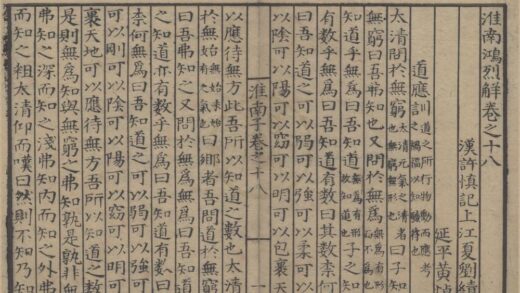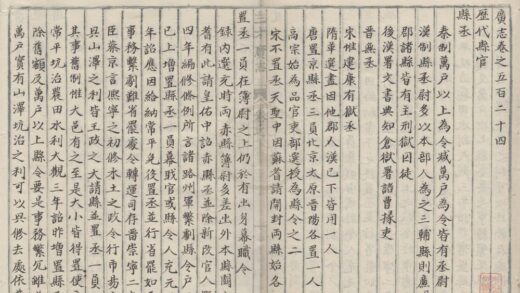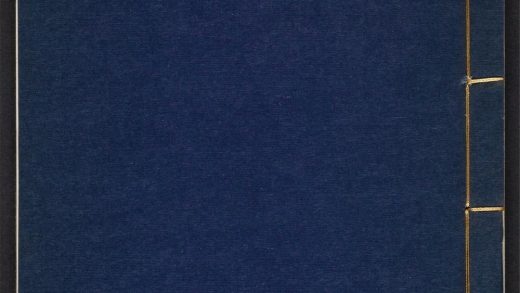【作品基本信息】
| 作者 | 冷枚 |
| 品名 | 耕织图册 |
| 朝代 | 清代 |
| 文件大小 | 882.6MB |
| 分辨率(DPI) | 300×300 |
| 像素大小 | 2832×2120 |
| 尺寸(CM) | 23.97×17.94 |
| 作品数量 | 49 |
| 作品收藏 | 台北故宫博物院 |
| 图片格式 | 默认提供TIF和JPG两个版本 |
基本数据
| 藏品类型 | 绘画 |
| 品名 |
清冷枚耕织图 册 Scenes of Agriculture and Sericulture |
| 分类 | 绘画 |
| 作者 | 冷枚 |
| 数量 | 一册:二十六开(本幅二十三开四十六幅,前副叶三开) |
典藏尺寸
| 【位置】 | 【尺寸】(公分) |
| 本幅 | 22.8×24 |
| 本幅上方 | 8.4×24 |
| 前副叶 | 25.6×25.6 |
质地
| 【质地位置】 | 【质地】 |
| 本幅 | 绢 |
| 本幅上方 | 纸 |
| 前副叶 | 纸 |
题跋数据
| 【题跋类别】 | 【作者】 | 【位置】 | 【款识】 | 【书体】 | 【全文】 |
| 题跋 | 清圣祖 | 前副叶 | 康熙三十五年(公元一六九六年)春二月社日题并书。 | 行书 | 御制耕织图序。朕早夜勤毖。研求治理。念生民之本。以衣食为天。常读豳风无逸诸篇。其言稼穑蚕桑。纎悉具备。昔人以此被之管弦。列于典诰。有天下国家者。洵不可不留连三复于其际也。西汉诏令。最为近古。其言曰。农事伤则饥之本也。女红害则寒之原也。又曰老耆以寿终幼孤得遂长。欲臻斯理者。舍本务其曷以哉。朕每廵省风謡。乐观农事。于南北土疆之性。黍稌播种之宜。节候早晚之殊。蝗蝻捕治之法。素爱咨询。知此甚晰。听政时。恒诸臣工言之。于丰泽园之侧。治田数畦。环以溪水。阡陌井然在目。桔槔之声盈耳。岁收嘉禾数十钟。陇畔树桑。傍列蚕舍。浴茧缫丝。恍然如茆檐蔀屋。因构知稼轩秋云亭以临观之。古人有言。衣帛当思织女之寒。食粟当念农夫之苦。朕惓惓于此。至深且切也。爰绘耕织图各二十三幅。朕于每幅制诗一章。以吟咏其勤苦。而书之于图。自始事迄终事。农人胼手胝足之劳。蚕女茧丝机杼之瘁。咸备极其情状。复命镂板流传。用以示子孙臣庶。俾知粒食维艰。授衣匪易。书曰惟土爱物厥心。臧庶于斯图有所感发焉。且欲令寰宇之内。皆敦崇本业。勤以谋之。俭以积之。衣食丰饶。以共跻于安和富寿之域。斯则朕嘉惠元元之至意也夫。康熙三十五年(公元一六九六年)春二月社日题并书。 |
|
印记: 佩文斋、康熙宸翰、稽古右文之章 |
|||||
印记资料
| 【印记类别】 | 【印记】 |
| 鉴藏宝玺 | 乾隆御览之宝 |
| 鉴藏宝玺 | 乾隆鉴赏 |
| 鉴藏宝玺 | 石渠宝笈 |
| 鉴藏宝玺 | 三希堂精鉴玺 |
| 鉴藏宝玺 | 宜子孙 |
| 鉴藏宝玺 | 乾隆御览之宝(重二十二) |
| 鉴藏宝玺 | 八旬天恩(重二十二) |
| 鉴藏宝玺 | 古希天子(重二十二) |
| 鉴藏宝玺 | 太上皇帝宝(重二十二) |
| 鉴藏宝玺 | 养心殿鉴藏宝 |
| 鉴藏宝玺 | 嘉庆御览之宝 |
参考数据
| 【类别】 | 【参考数据】 |
| 收藏着录 | 石渠宝笈初编(养心殿),上册,页507 |
| 收藏着录 | 故宫书画录(卷八),第四册,页155 |
| 收藏着录 | 故宫书画图录,第二十五册,页50-57 |
| 内容简介(中文) | 冷枚(十七世纪后期至十八世纪前期),字吉臣,山东胶州人。康熙年间供奉内廷。画法师焦秉贞,擅长人物仕女及山水楼阁,得力于西法写生。耕织图是描写民间农事和纺织的生活情况,此题材始绘于南宋初,元、明有刻本流传。清康熙年间,焦秉贞奉诏绘制新本,圣祖为之题诗作序,镂版印赐诸臣。此册乃冷枚摹写焦本,配以版印康熙诗、序,装裱而成。设色典丽妍雅,颇得师传。 |
| 内容简介(英文) | Leng Mei served in the K’ang-hsi reign (1662-1722) as a court painter. Following Chiao Ping-chen, his contemporary, Leng specialized in figures, especially ladies, as well as landscapes and buildings. He was also fluent in Western techniques. This album includes scenes of farming and silk-making in traditional China. This subject goes back to the early Southern Sung (1127-1279) and versions were done in the following Yuan and Ming dynasties. The K’ang-hsi emperor inscribed poems and a preface for the project under his reign and lithograph copies were presented to officials. These paintings were copied by Leng Mei and bound with a printed version of K’ang-hsi’s writing. The style of this traditional subject is elegant and classical. |
| 内容简介(中文) |
冷枚(公元十八世纪),字吉臣,山东胶州人。康熙年间供奉内廷,作品见于康熙四十二年至五十六年间(一七0三–一七一七),善画人物,书法工中带写,点缀屋宇精细如界画,却生动有致。 按清院本耕织图四十六幅,原为康熙年间内庭祇候焦秉真所画,以其能曲画农家苦乐,故诏命镂版印赐臣工,现犹有冷枚、陈枚诸人仿作传世。冷枚为焦氏弟子,本幅笔墨洁净,赋色韶秀,颇得师传。本幅册之尺寸大小,及幅上之乾隆御题诗句,皆与焦秉真原画册同。 |
| 内容简介(英文) |
Leng Mei, whose style name was Chi-ch’en, was from Chiao-chou, Shantung. During the K’ang-hsi period (1662-1723), he served as a Court Painter. He excelled at painting figures. His technique in the detailed style carries a hint of impressionistic brushwork. His use of the brush in depicting architecture is fine and detailed, as in ruled line painting, yet extremely lively. A set of 46 works entitled Tilling and Weaving was originally painted by the K’ang-hsi period court master Chiao Ping-chen. Because he was able to capture farmers’ joys and hardships the emperor ordered these works engraved on plaques and bestowed them on various court artists. Although Chiao’s paintings are now lost, copies by his students Leng Mei, Ch’en Mei, and others have survived. In this work, the clarity of the brushwork complements the gorgeous and refined application of color demonstrating Leng Mei’s mastery of his teacher’s style. The measurements of the painting, along with the Ch’ien-lung emperor’s poetic inscription, are the same as Chiao’s original work. |
| 内容简介(中文) | 冷枚(十七世纪后至十八世纪初),字吉臣,山东胶州人。康熙年间供奉内廷。画法师焦秉贞,擅长人物仕女及山水楼阁,得力于西法写生。耕织图题材始于南宋初,描写古代农业社会的男耕女织,谷物从种植到收成入仓,养蚕从采桑育蚕到织布成衣的过程。清康熙年间,焦秉贞奉诏绘制新本,由圣祖题诗作序,镂版印赐诸臣。此册冷枚摹写焦本,裱配版印之康熙诗、序。设色典丽妍雅,颇得师传。(20100101) |
| 内容简介(英文) |
Leng Mei, a Kangxi court painter, followed Jiao Bingzhen’s (17th-18th c.) style and specialized in figures with landscapes and buildings, being also gifted at Western techniques. This theme of peace and prosperity in the countryside, appearing in the early Southern Song (1127-1279), shows men farming and women weaving. “Agriculture” depicts scenes from planting to harvest and storage, while “Sericulture” shows the process of picking mulberry leaves to raising silkworms to make silk. The Kangxi Emperor (r. 1662-1722) ordered Jiao Bingzhen to do a painted version, to which Kangxi added verse and a preface, which became a print set presented to officials. This is Leng Mei’s copy of Jiao Bingzhen’s version, the mounting with Kangxi’s poems and preface in print. The colors are elegant and beautiful, faithfully reflecting Jiao’s style.(20100101) |
| 参考书目 |
1.王耀庭、陈韵如,〈清冷枚耕织图(第十二、二十册)〉,收入王耀庭主编,《新视界 : 郎世宁与清宫西洋风》(台北:国立故宫博物院,2007年初版),页44-49。 2.国立故宫博物院编辑委员会,〈清冷枚耕织图〉,收入国立故宫博物院编辑委员会编,《界画特展图录》(台北:国立故宫博物院,1986年初版),页63。 3.廖宝秀,〈也可以清心 — 茶器、茶事、茶画〉,《故宫文物月刊》,第232期(2002年7月),页16。 4.马孟晶,〈冷枚耕织图册〉,收入刘芳如、张华芝主编,《群芳谱 — 女性的形象与才艺》(台北:国立故宫博物院,2003年初版一刷),页130-131。 5.林莉娜,〈画耕织图〉,收入冯明珠主编,《康熙大帝与太阳王路易十四特展》(台北:国立故宫博物院,2011年十月初版),页60。 |
【作品展示】
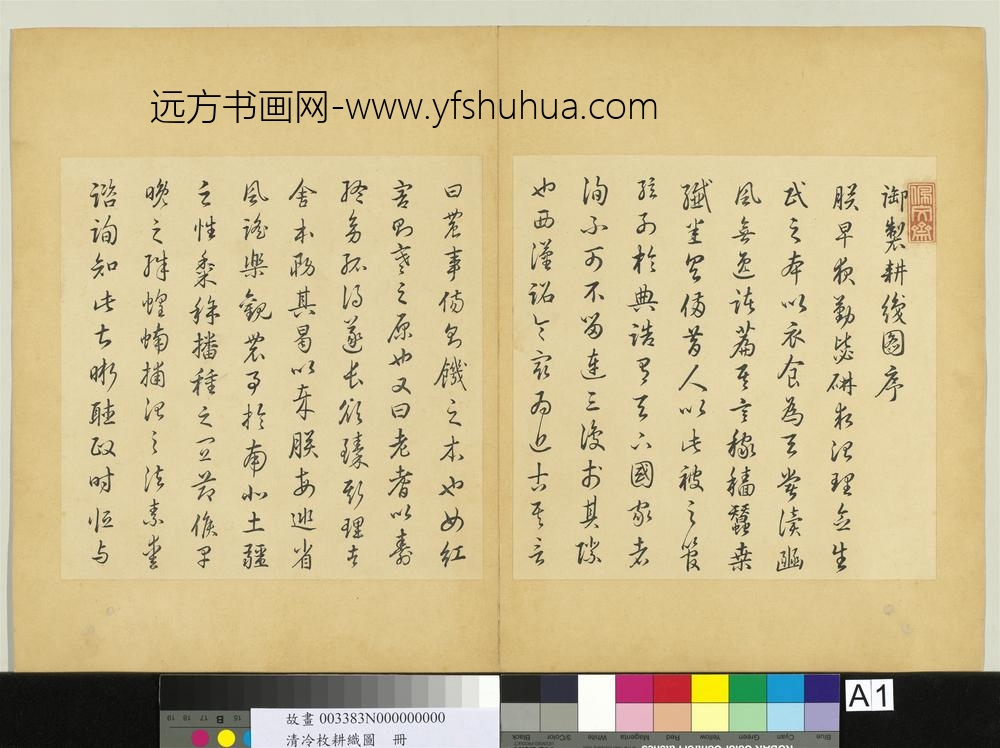
清冷枚耕织图册_
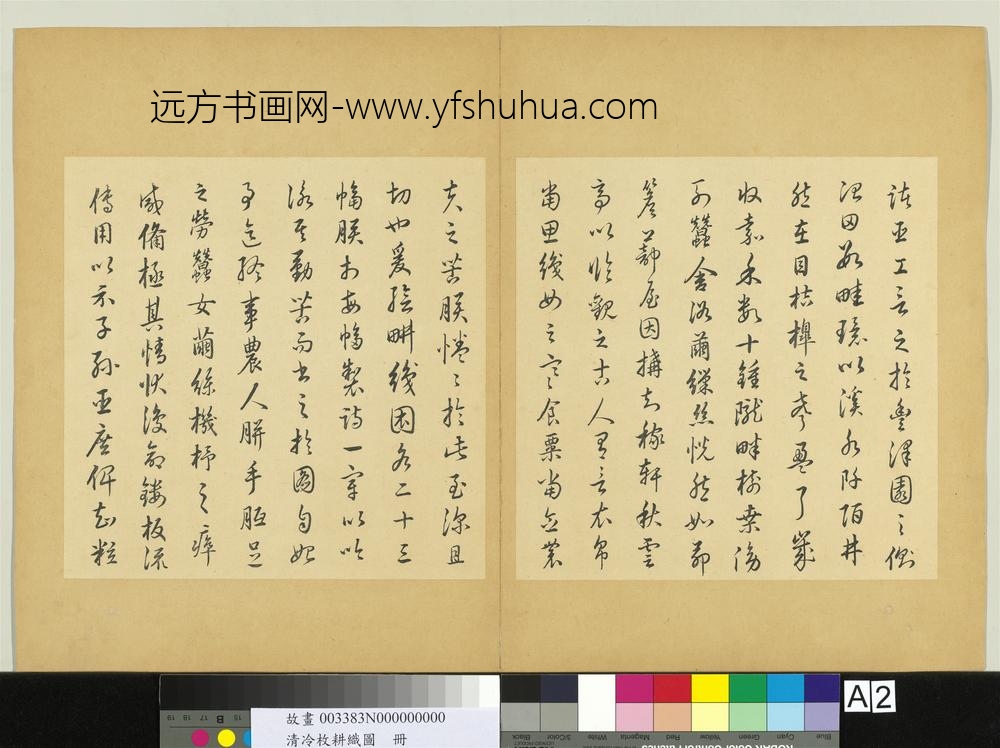
清冷枚耕织图册_
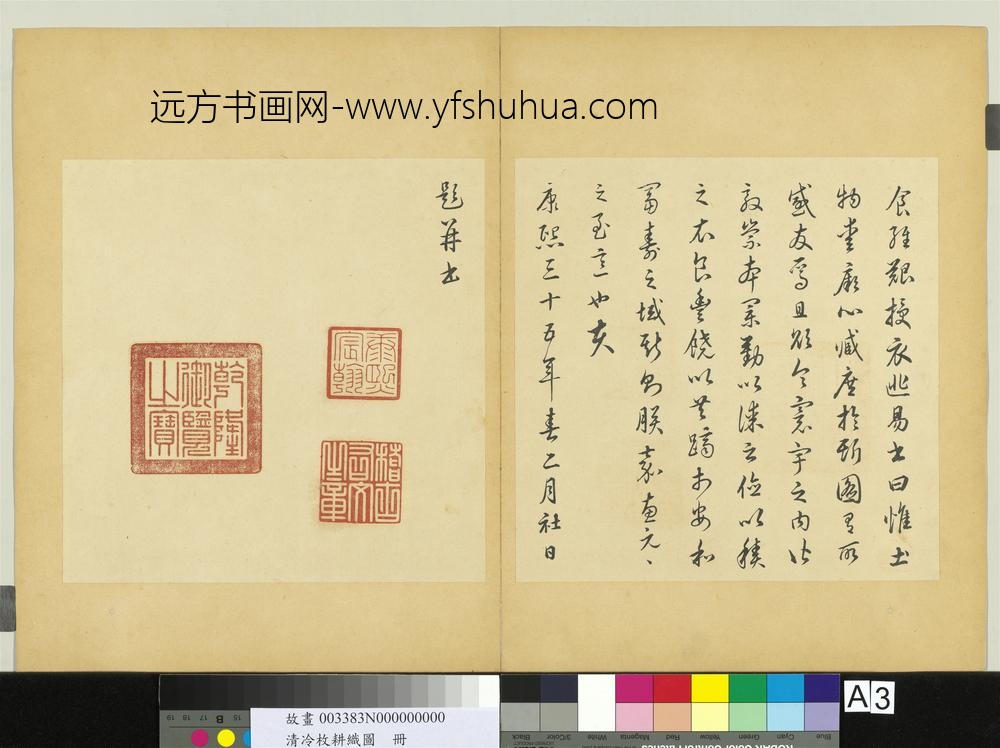
清冷枚耕织图册_
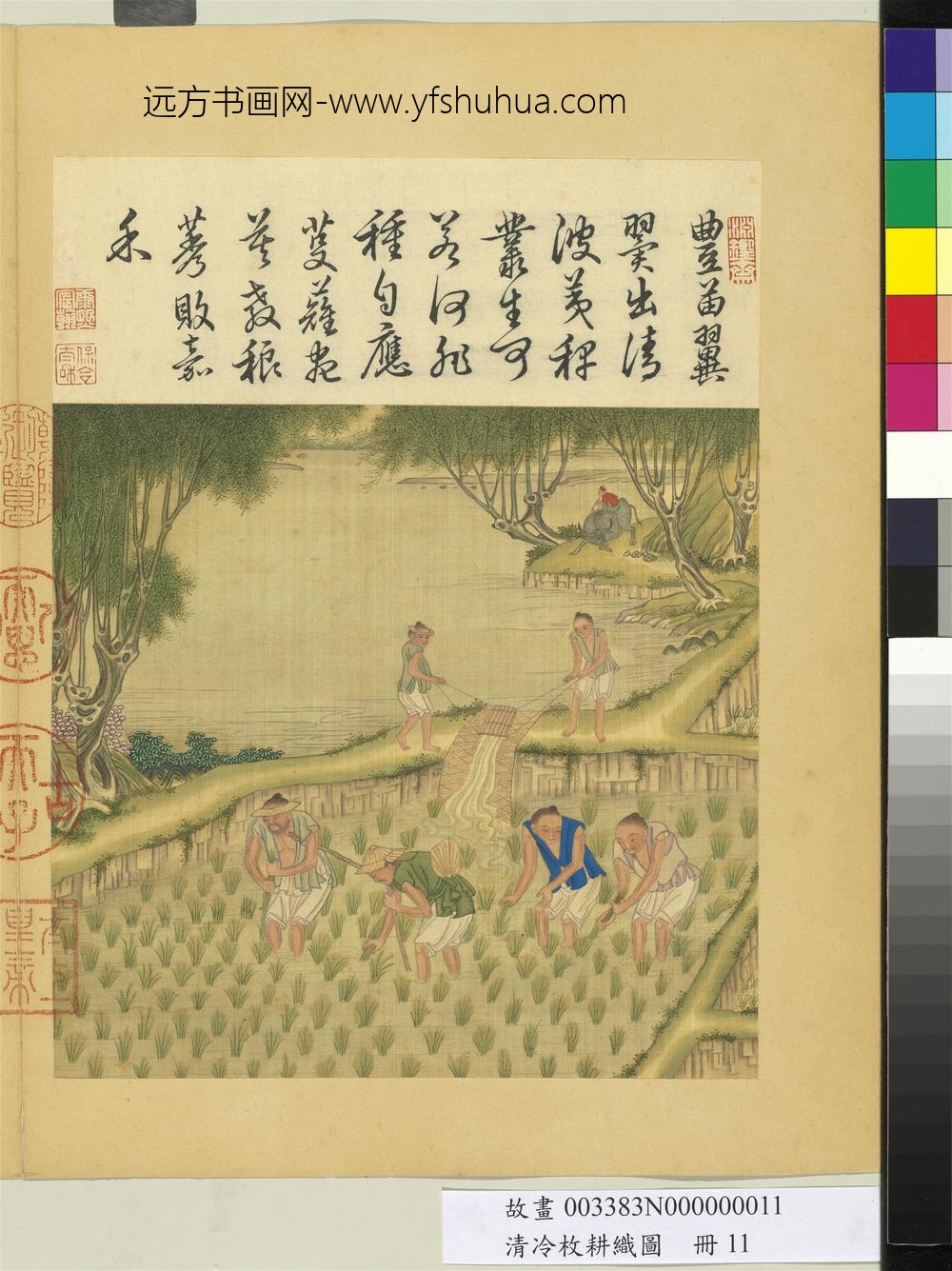
耕织图册_一耘
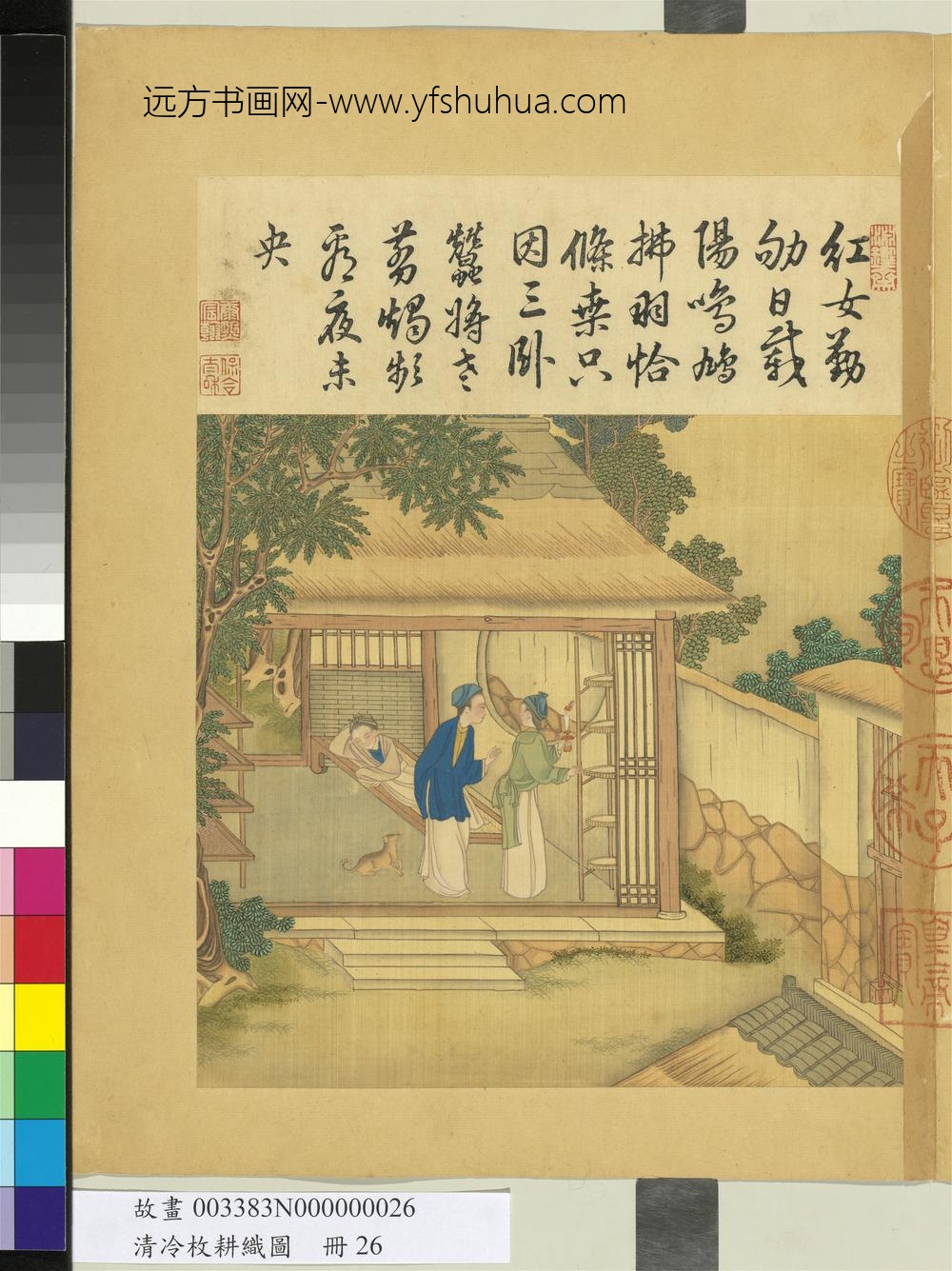
耕织图册_三眠
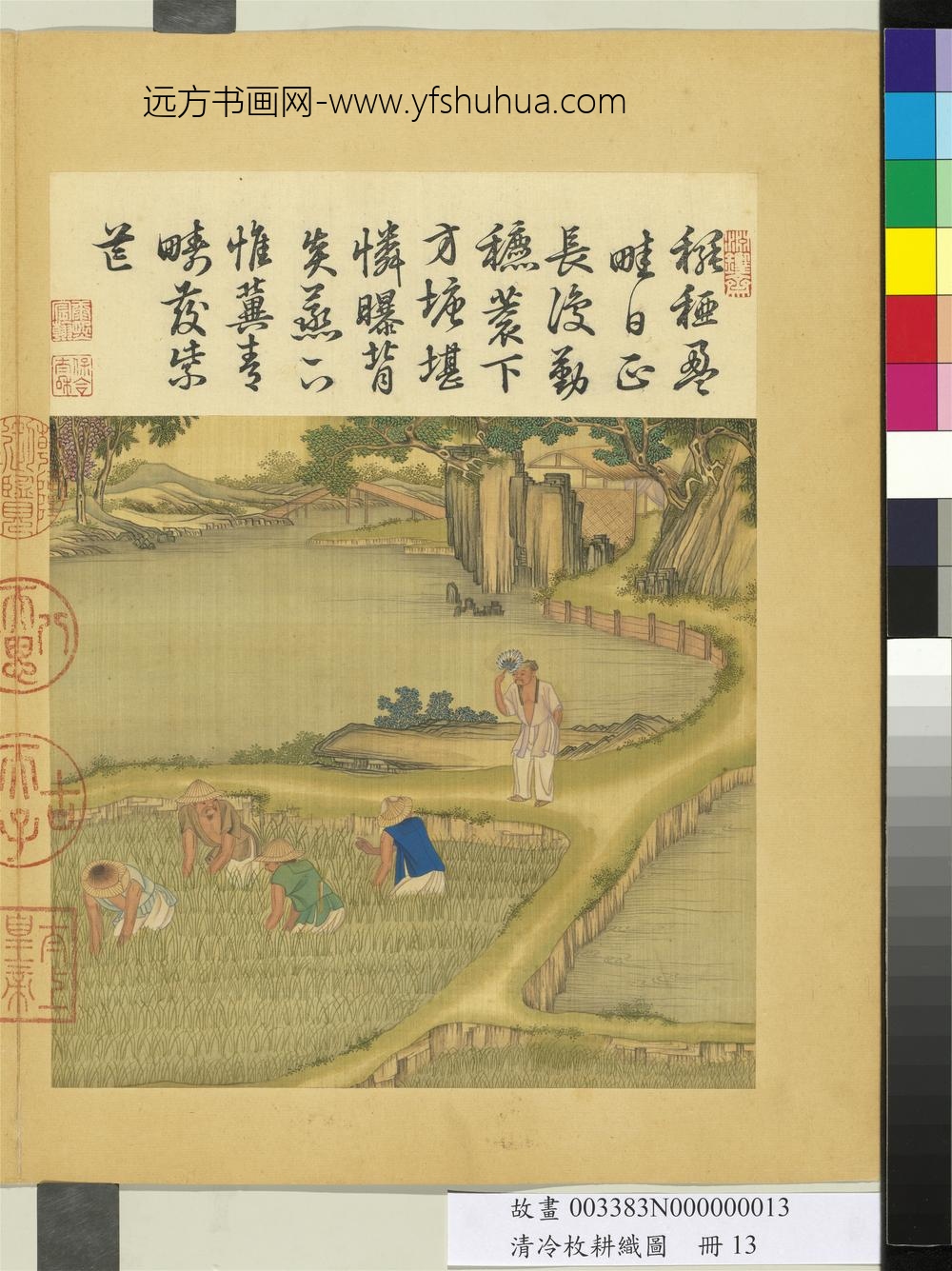
耕织图册_三耘
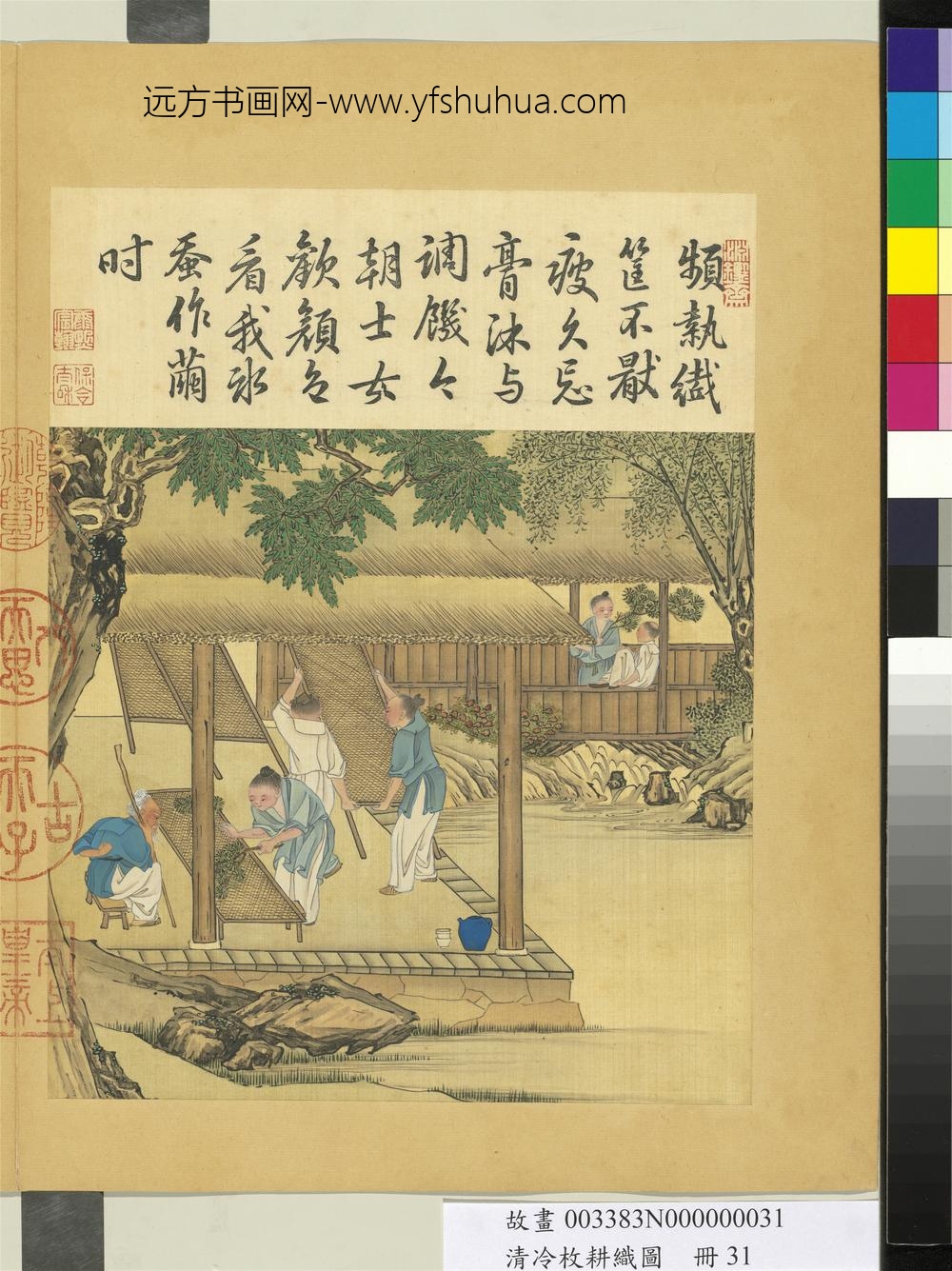
耕织图册_上簇
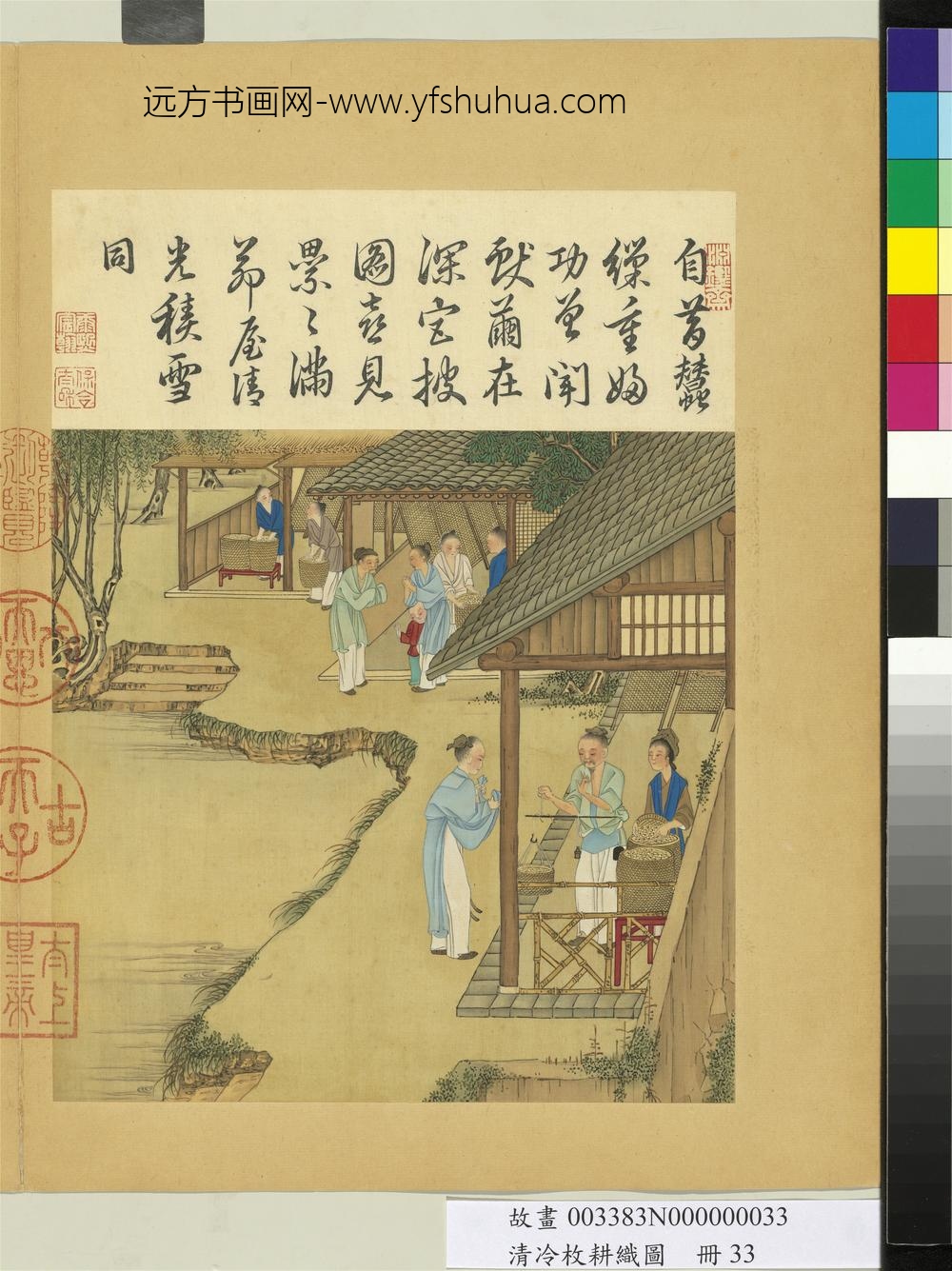
耕织图册_下簇
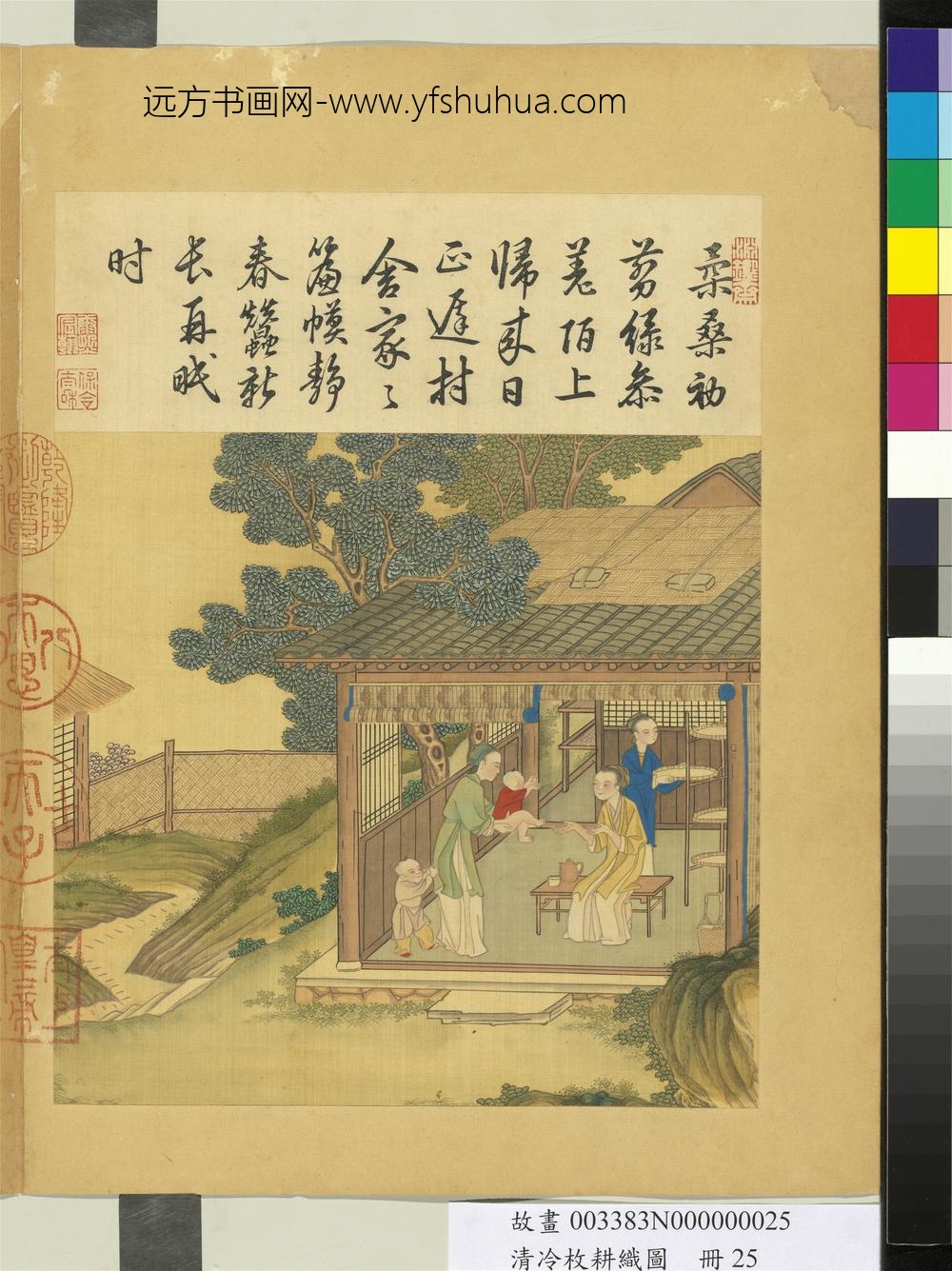
耕织图册_二眠
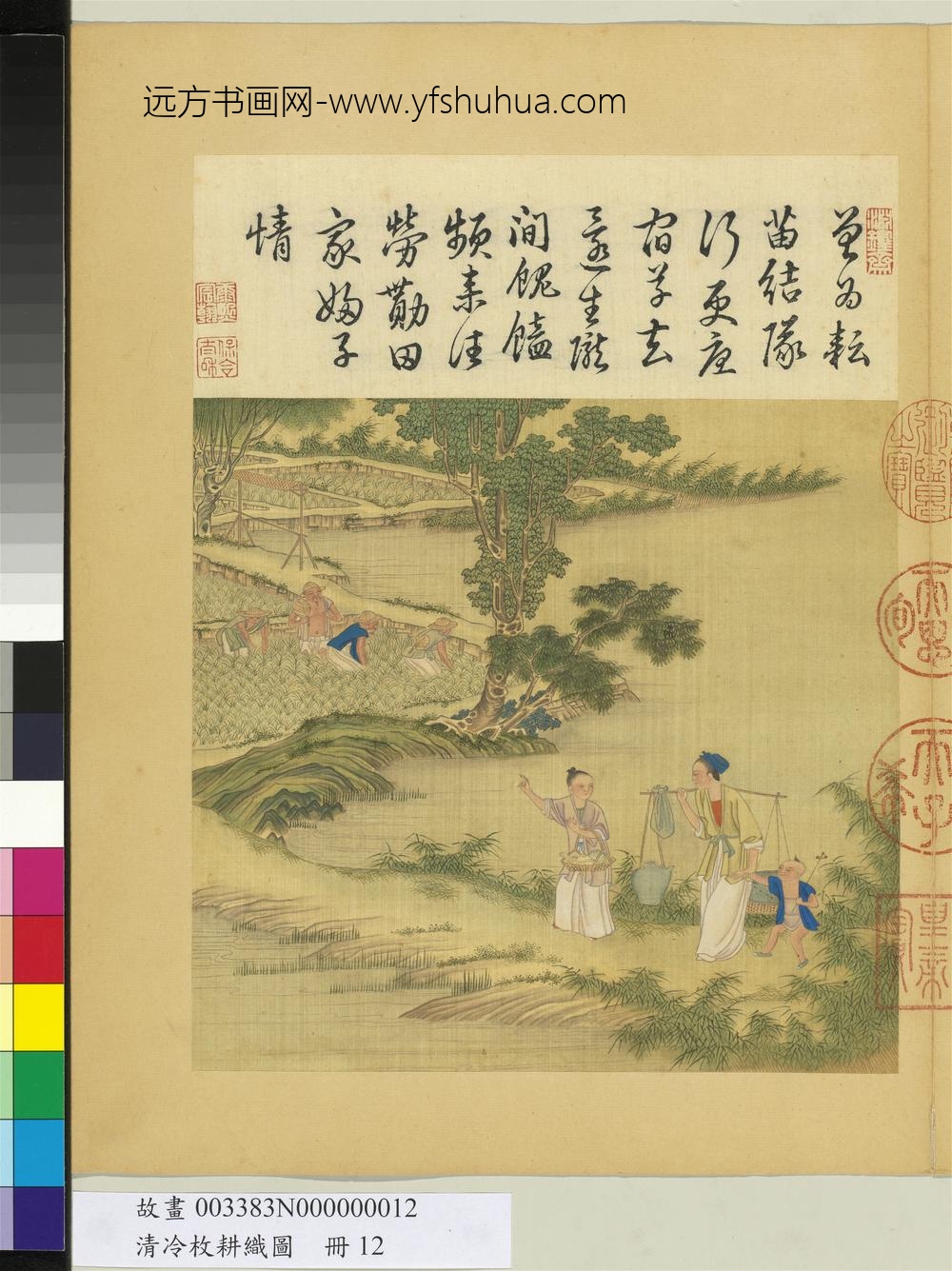
耕织图册_二耘
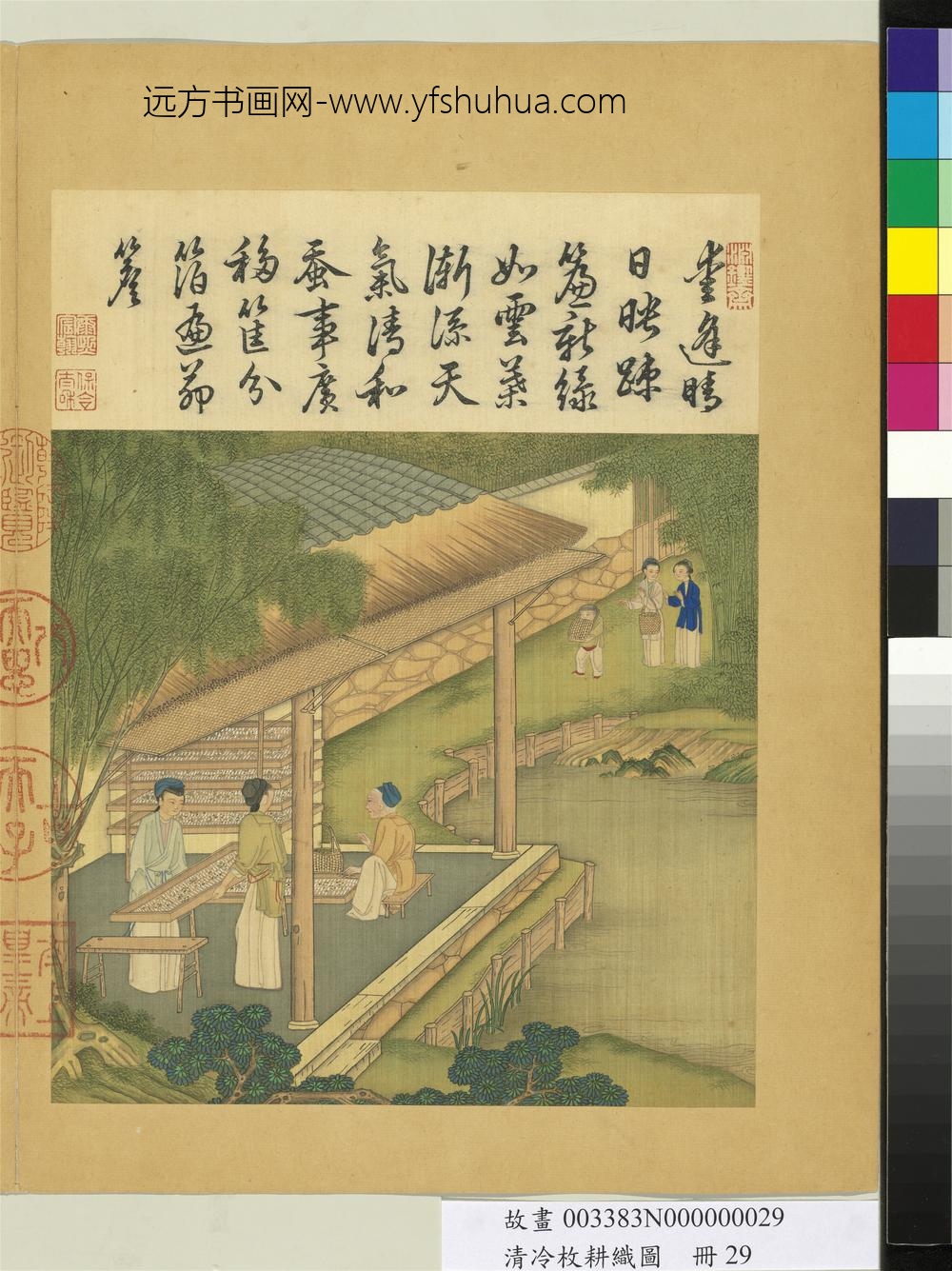
耕织图册_分箔
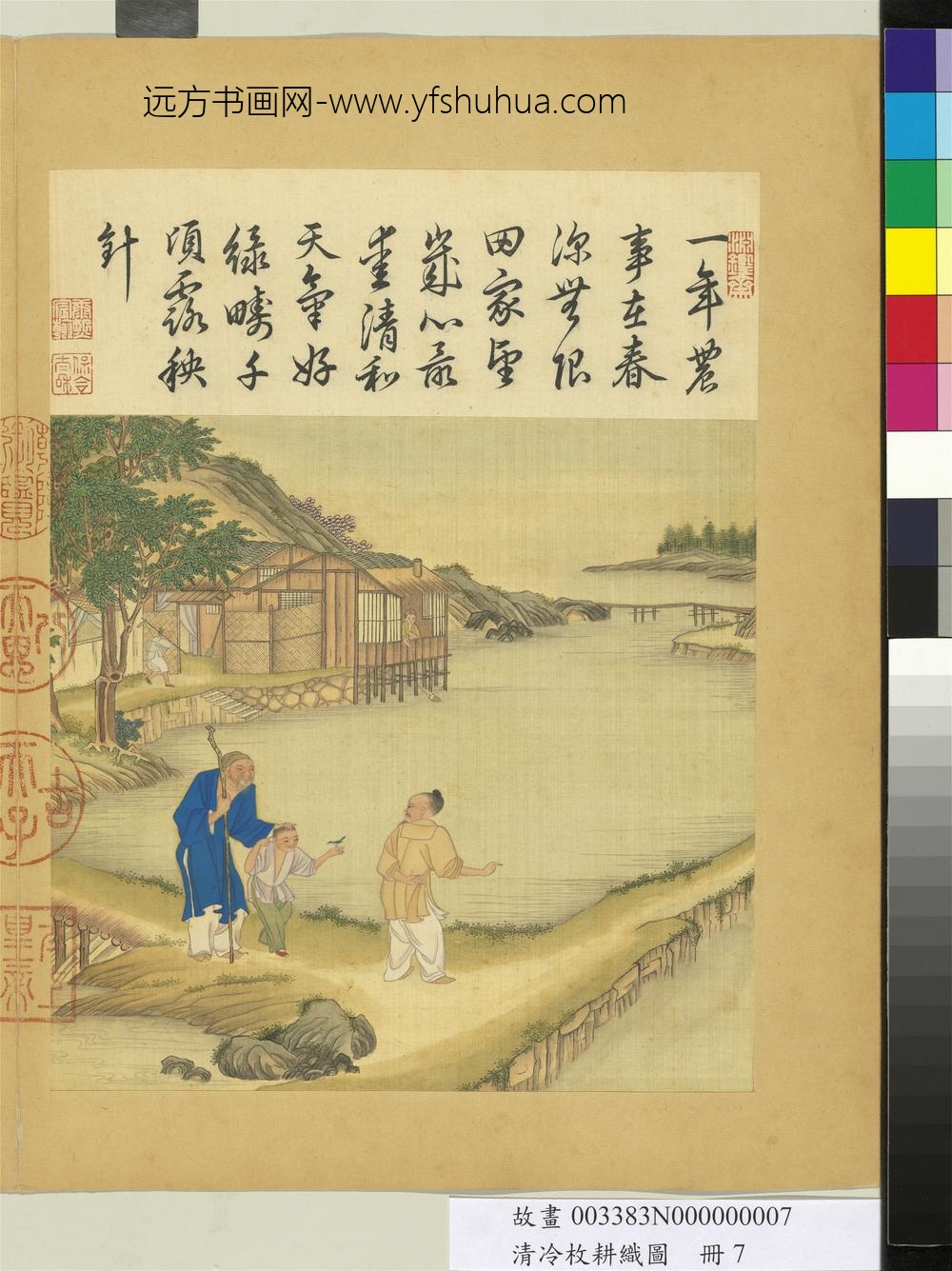
耕织图册_初秧
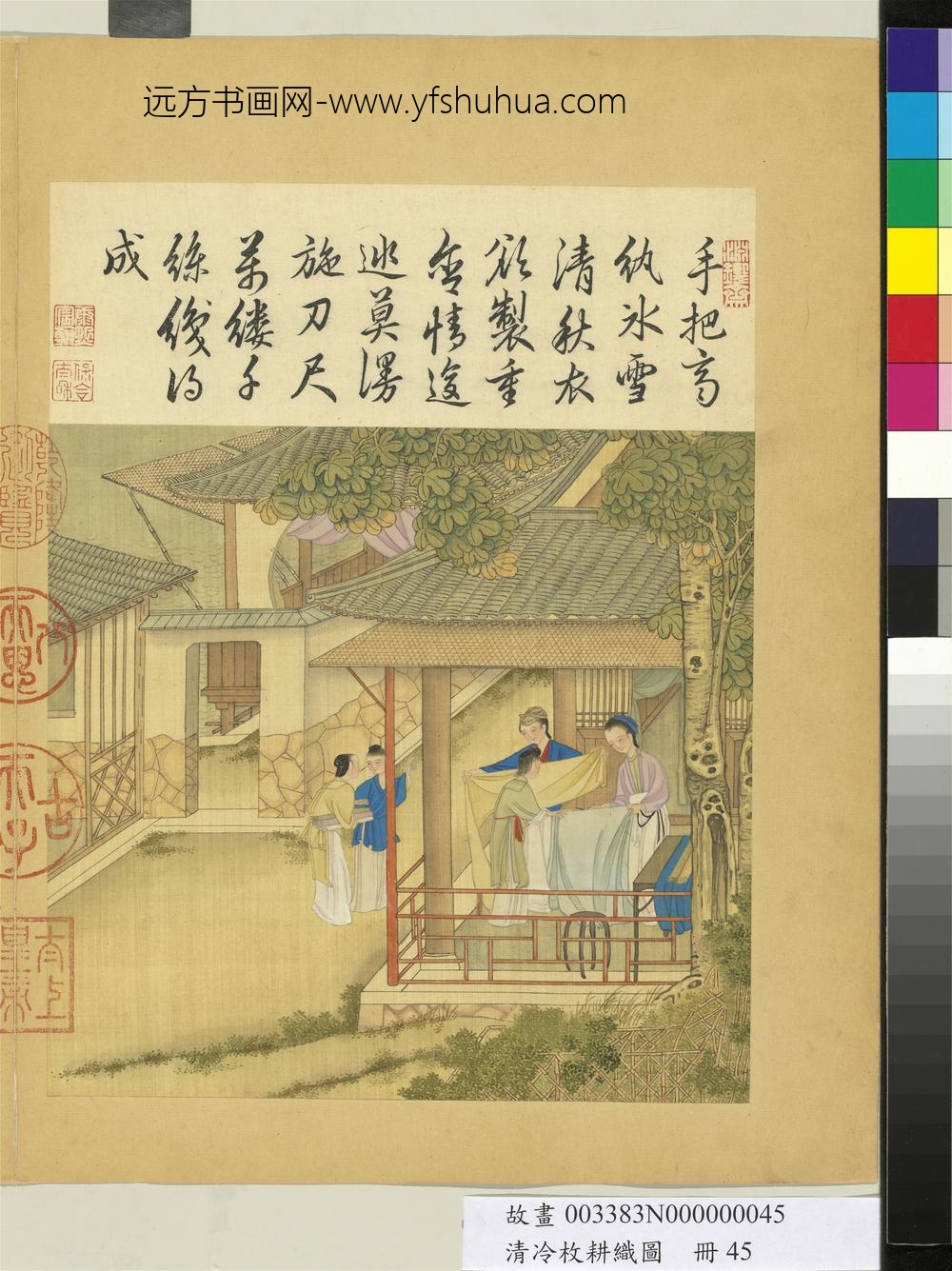
耕织图册_剪帛
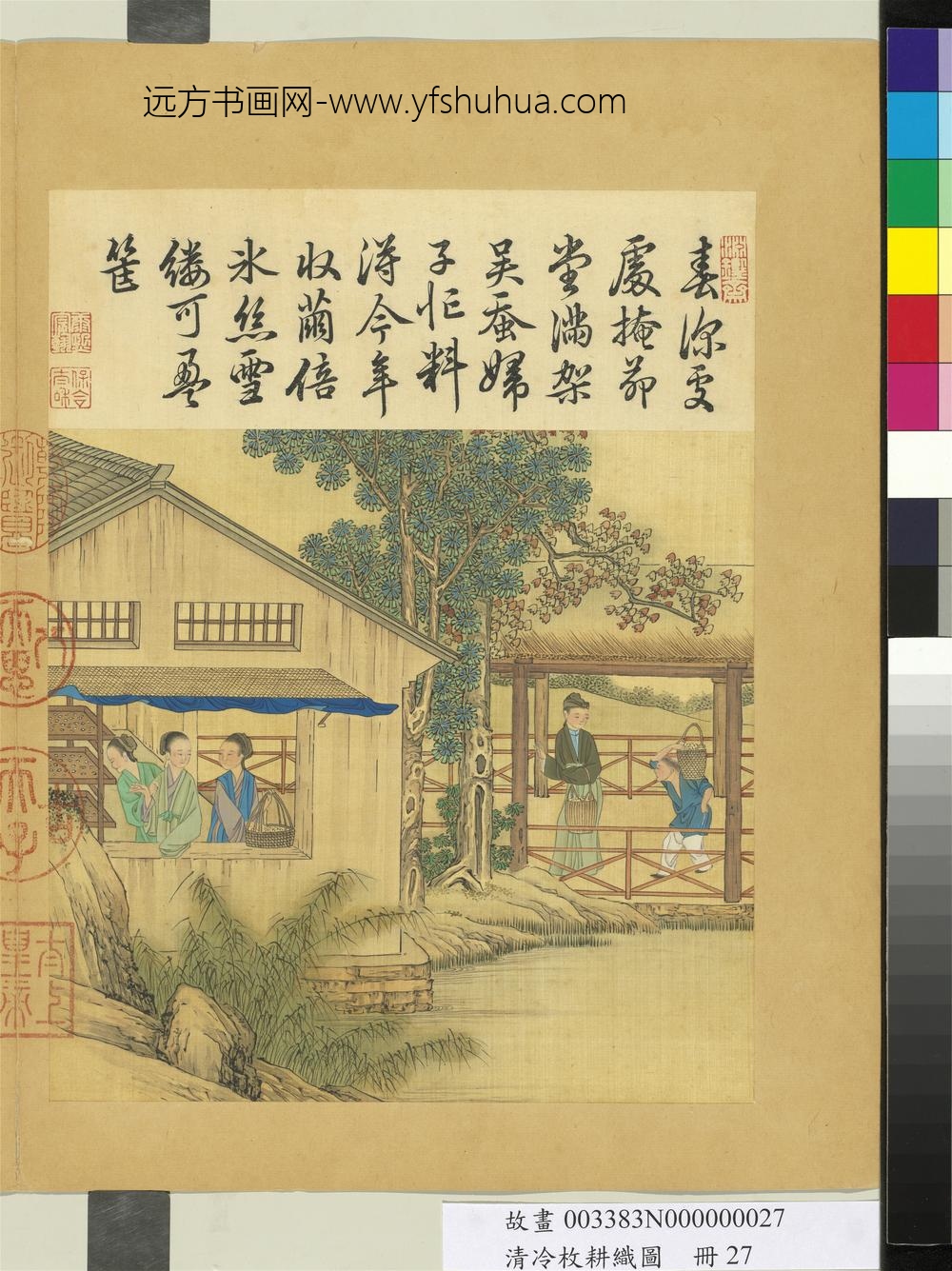
耕织图册_大起
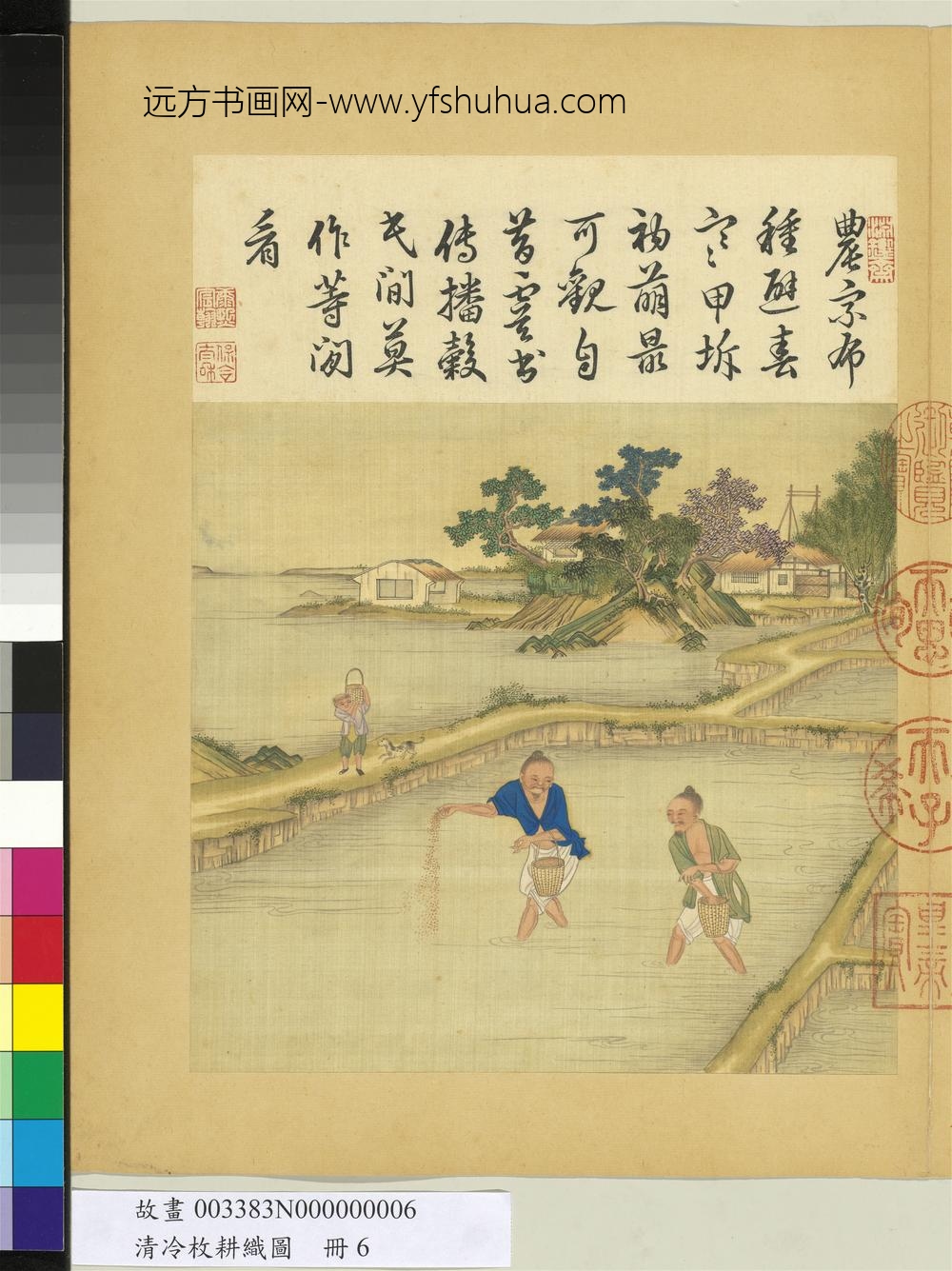
耕织图册_布秧
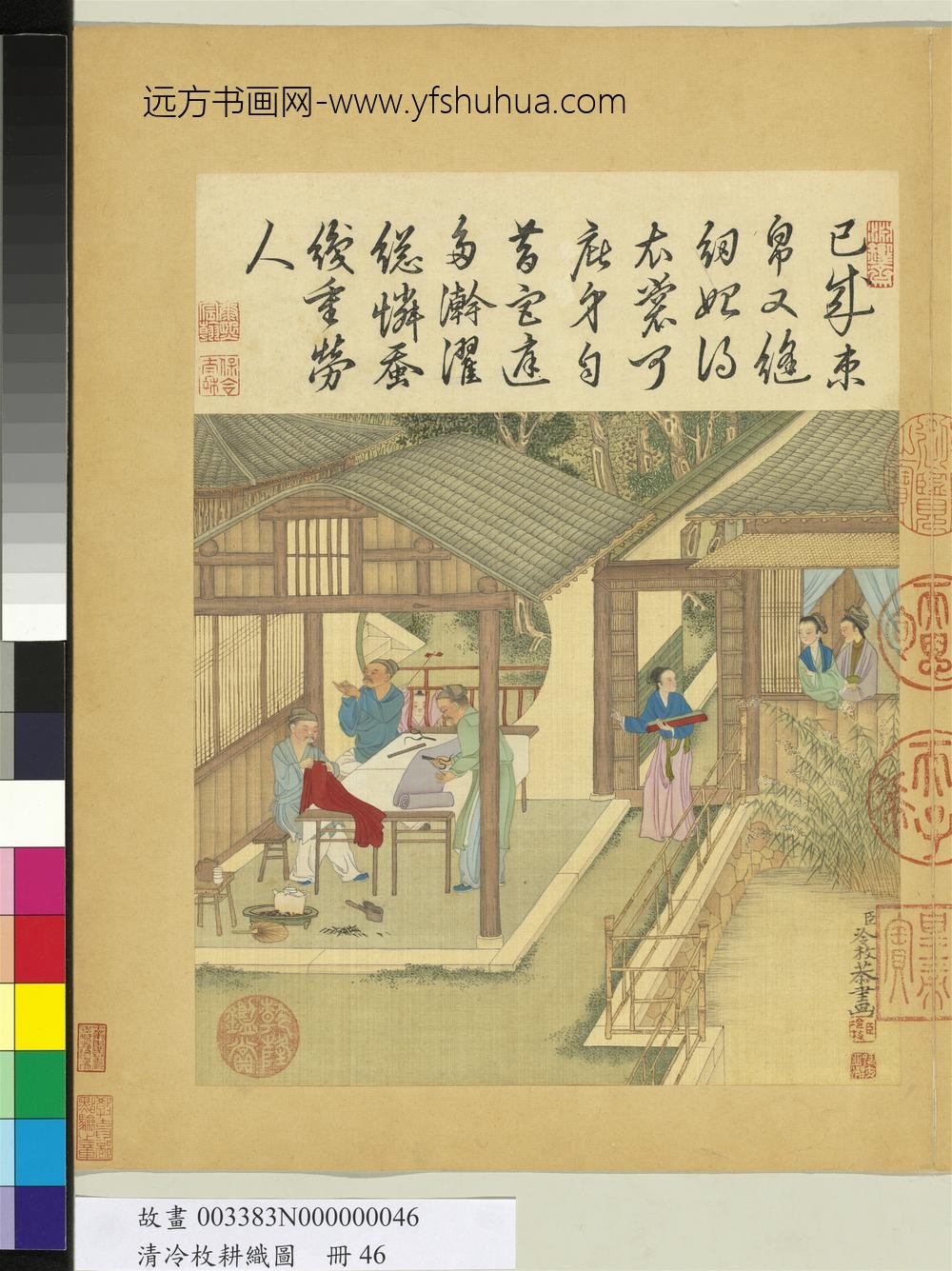
耕织图册_成衣
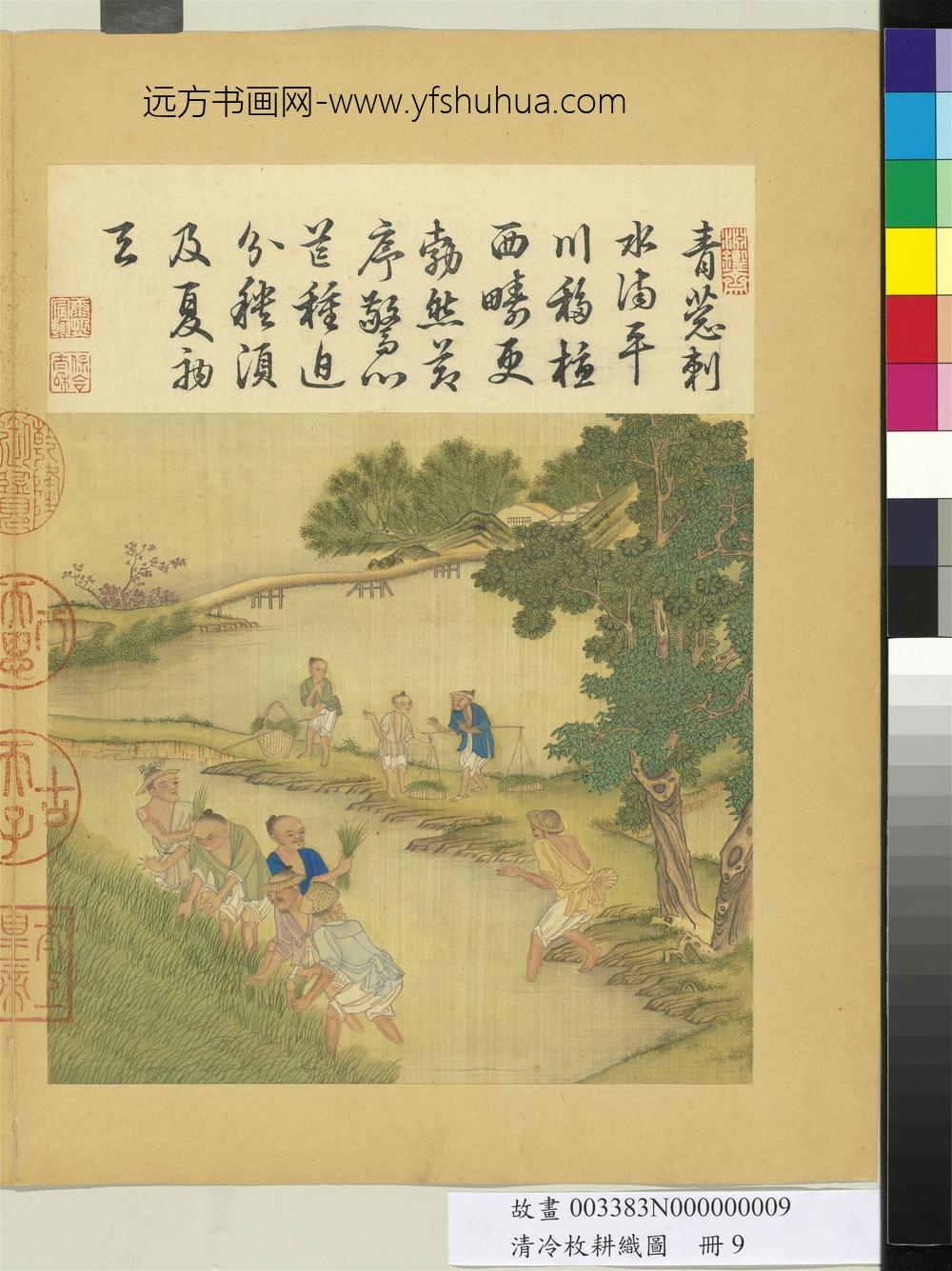
耕织图册_拔秧
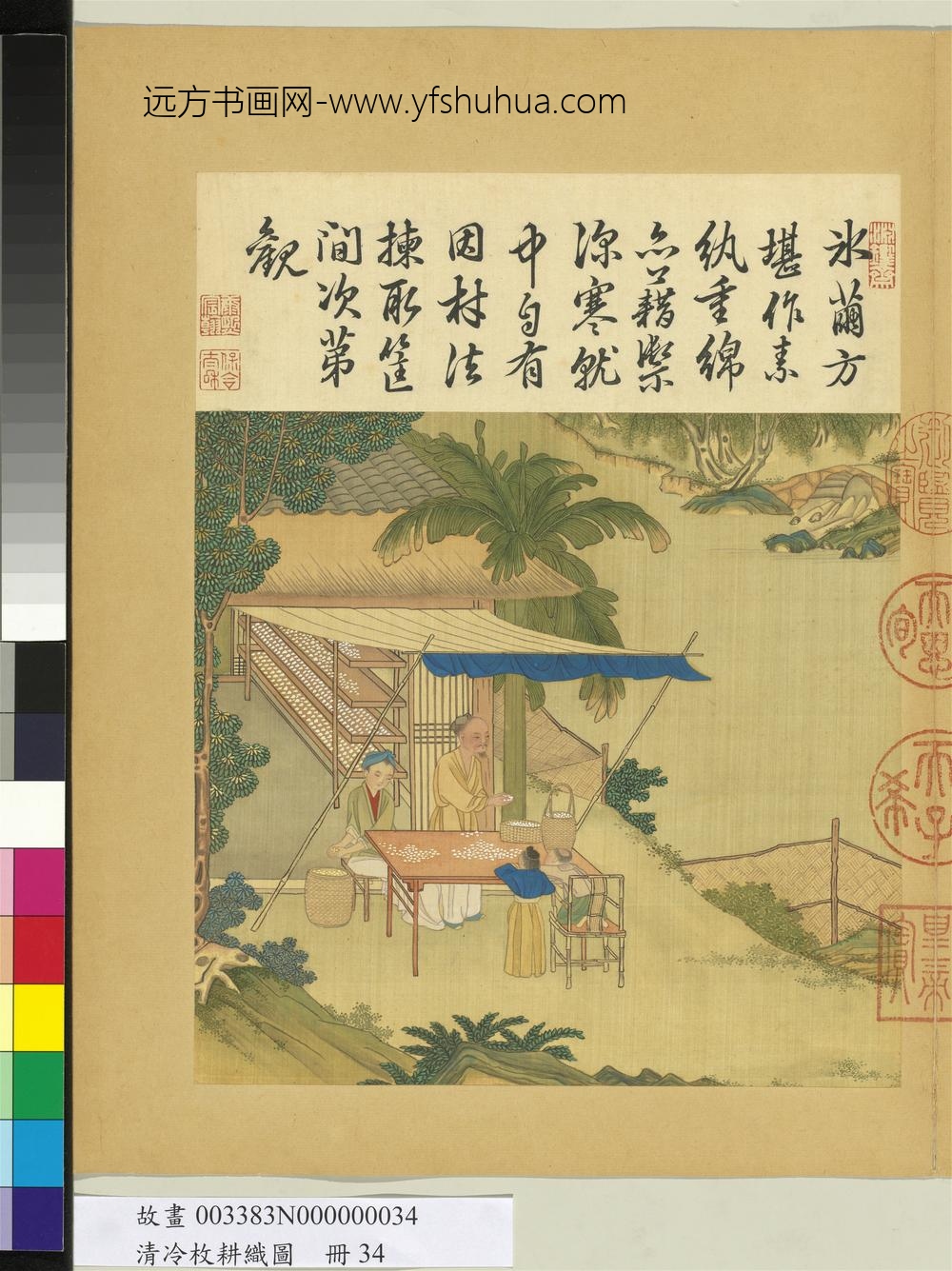
耕织图册_择茧
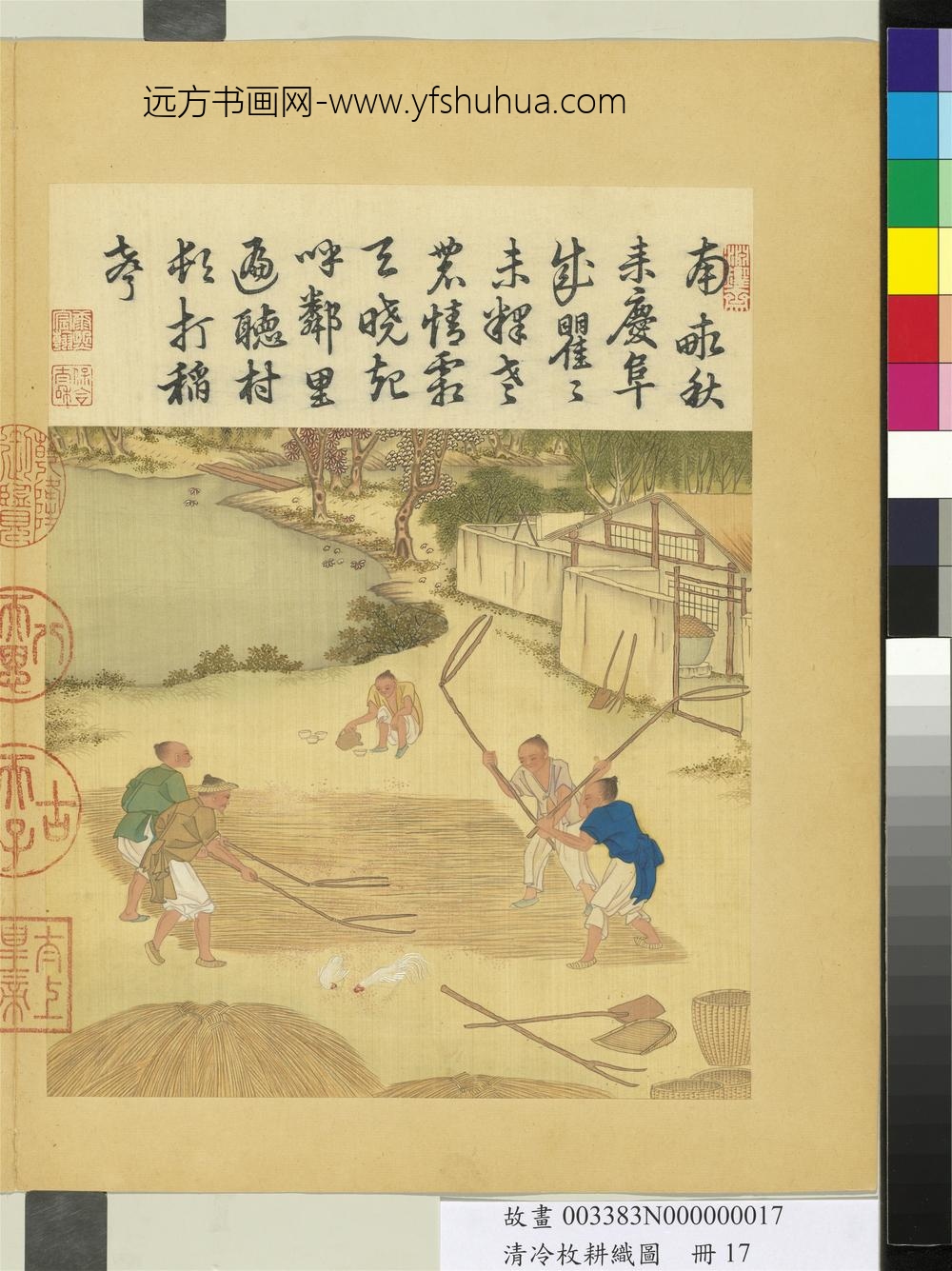
耕织图册_持穗
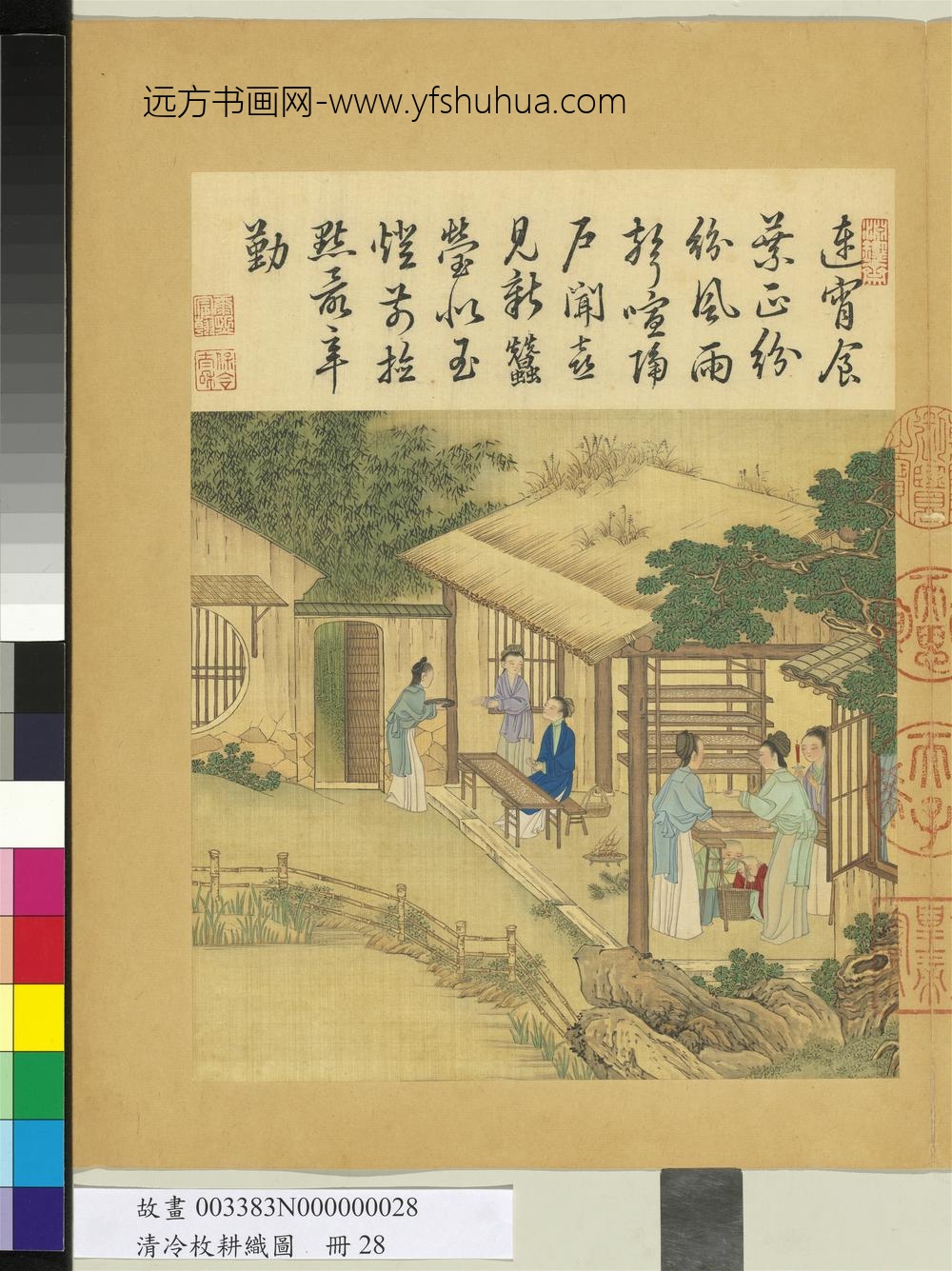
耕织图册_捉绩
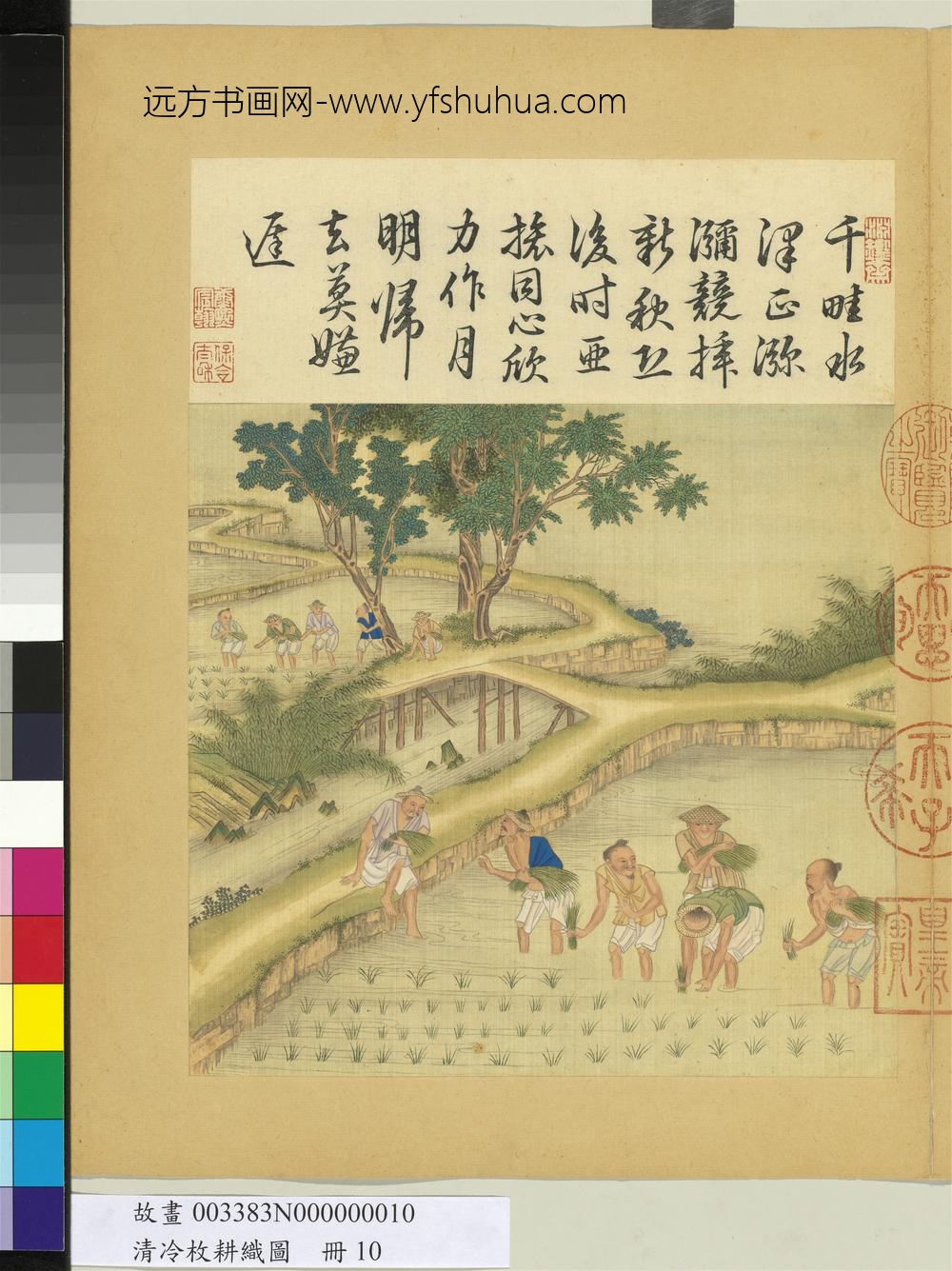
耕织图册_插秧
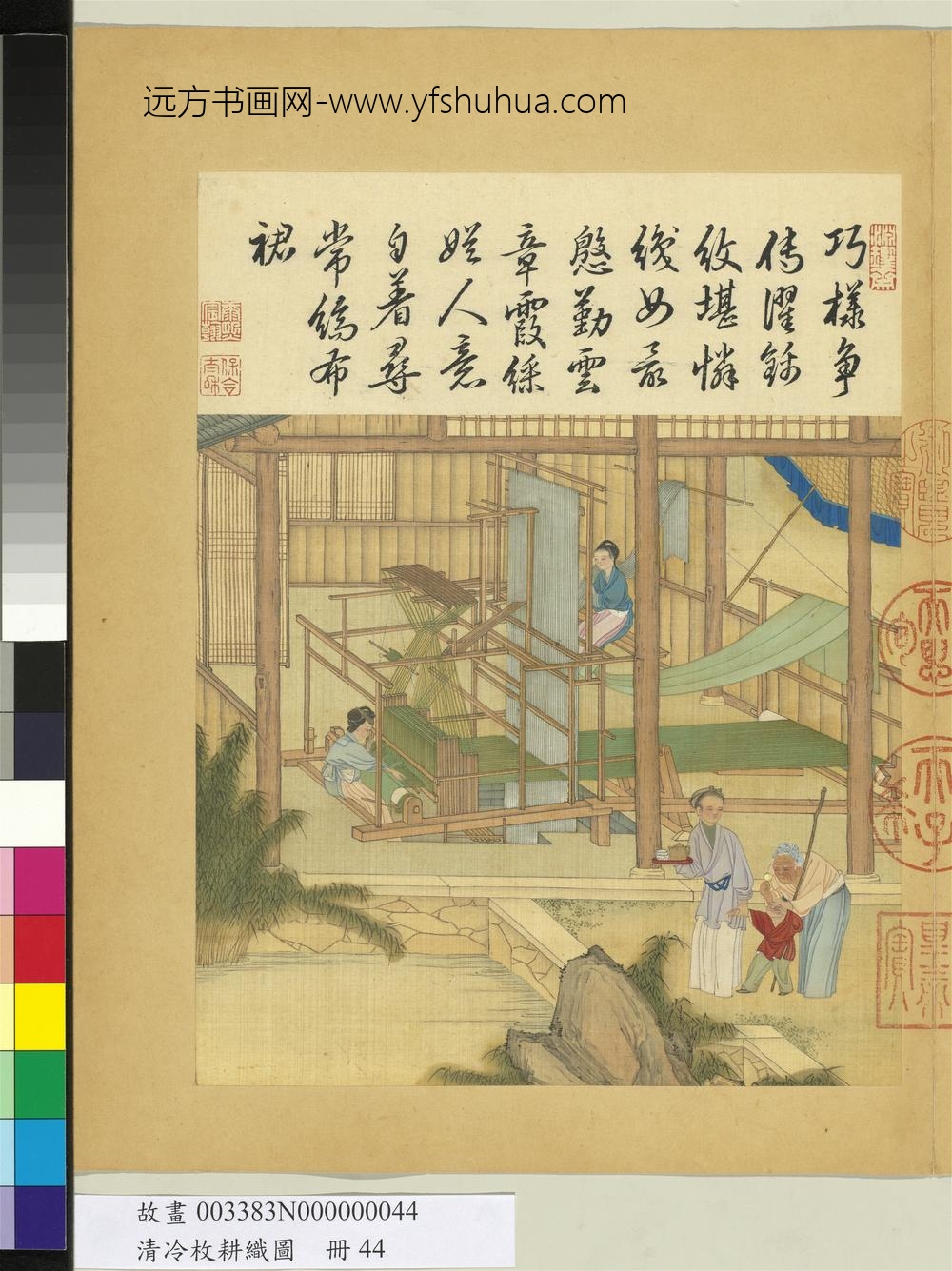
耕织图册_攀花
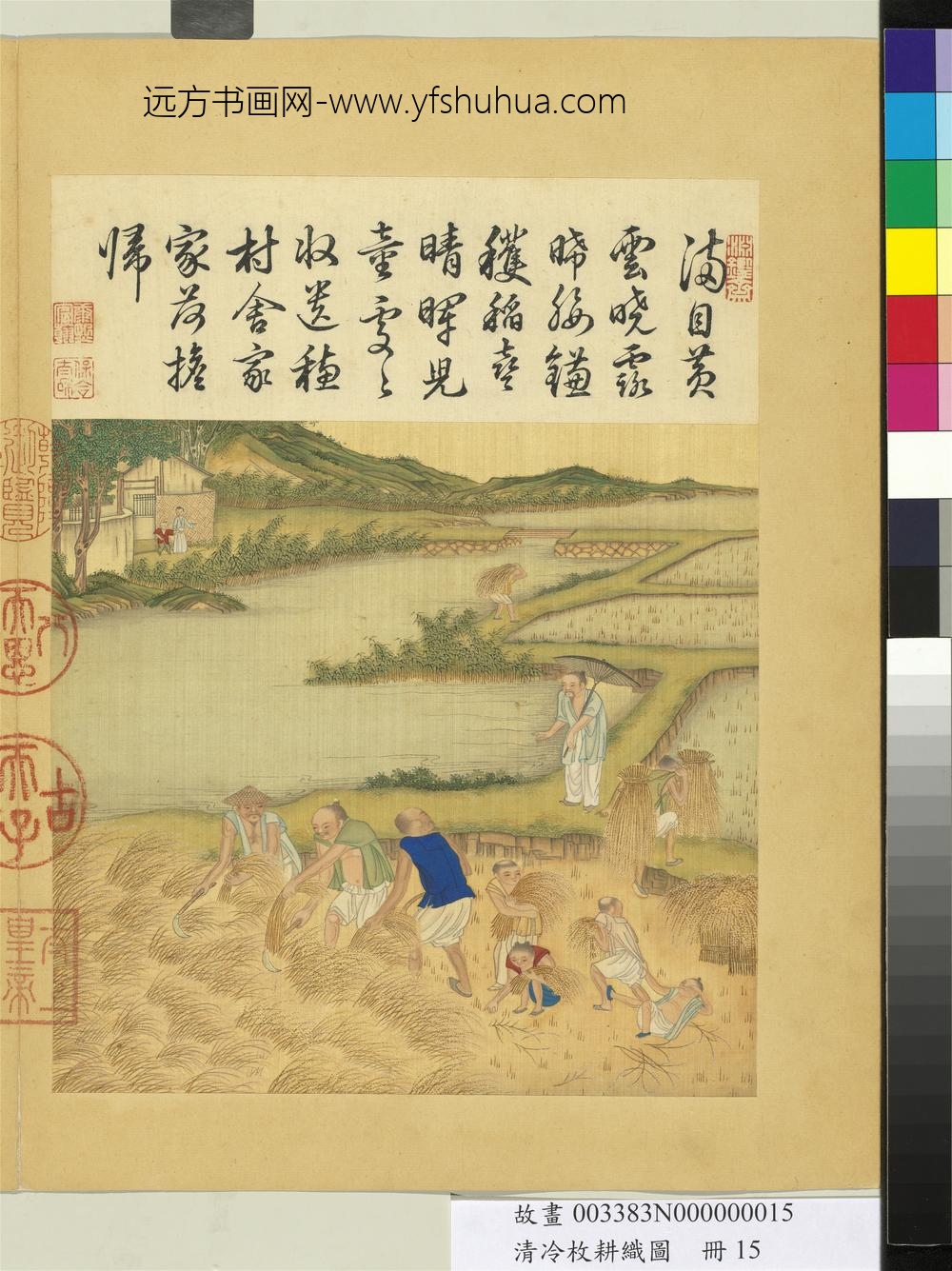
耕织图册_收刈
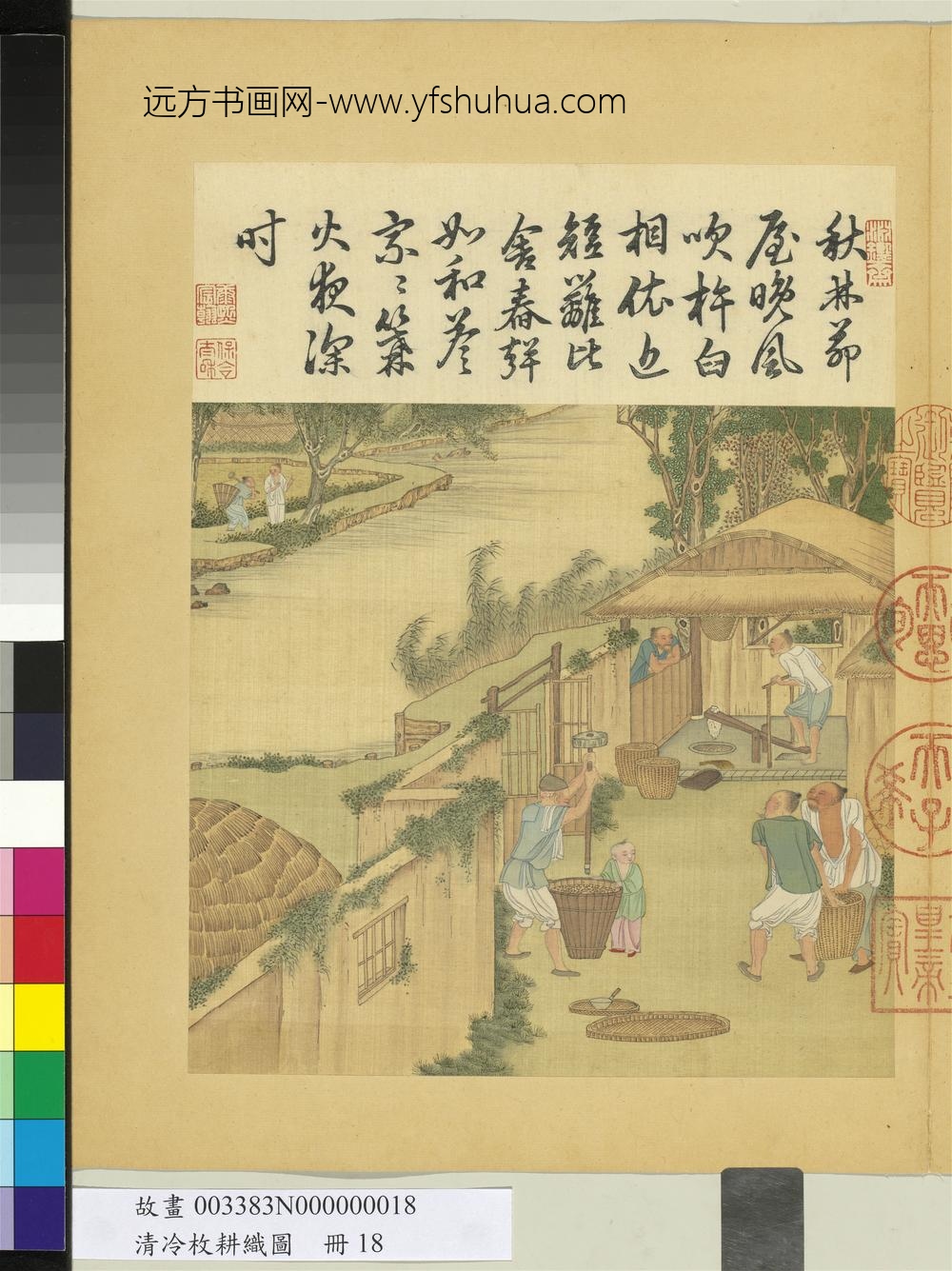
耕织图册_春碓
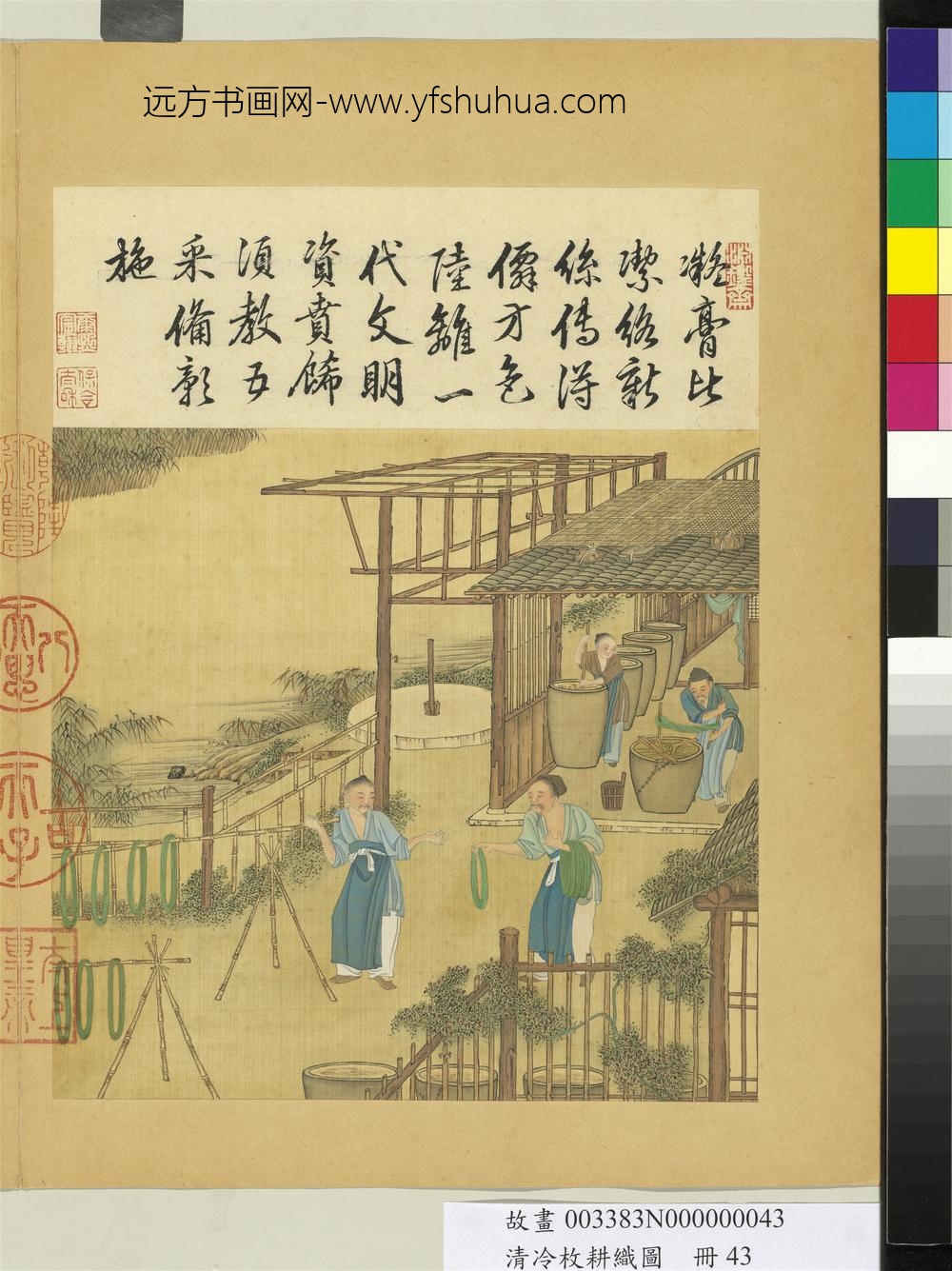
耕织图册_染色
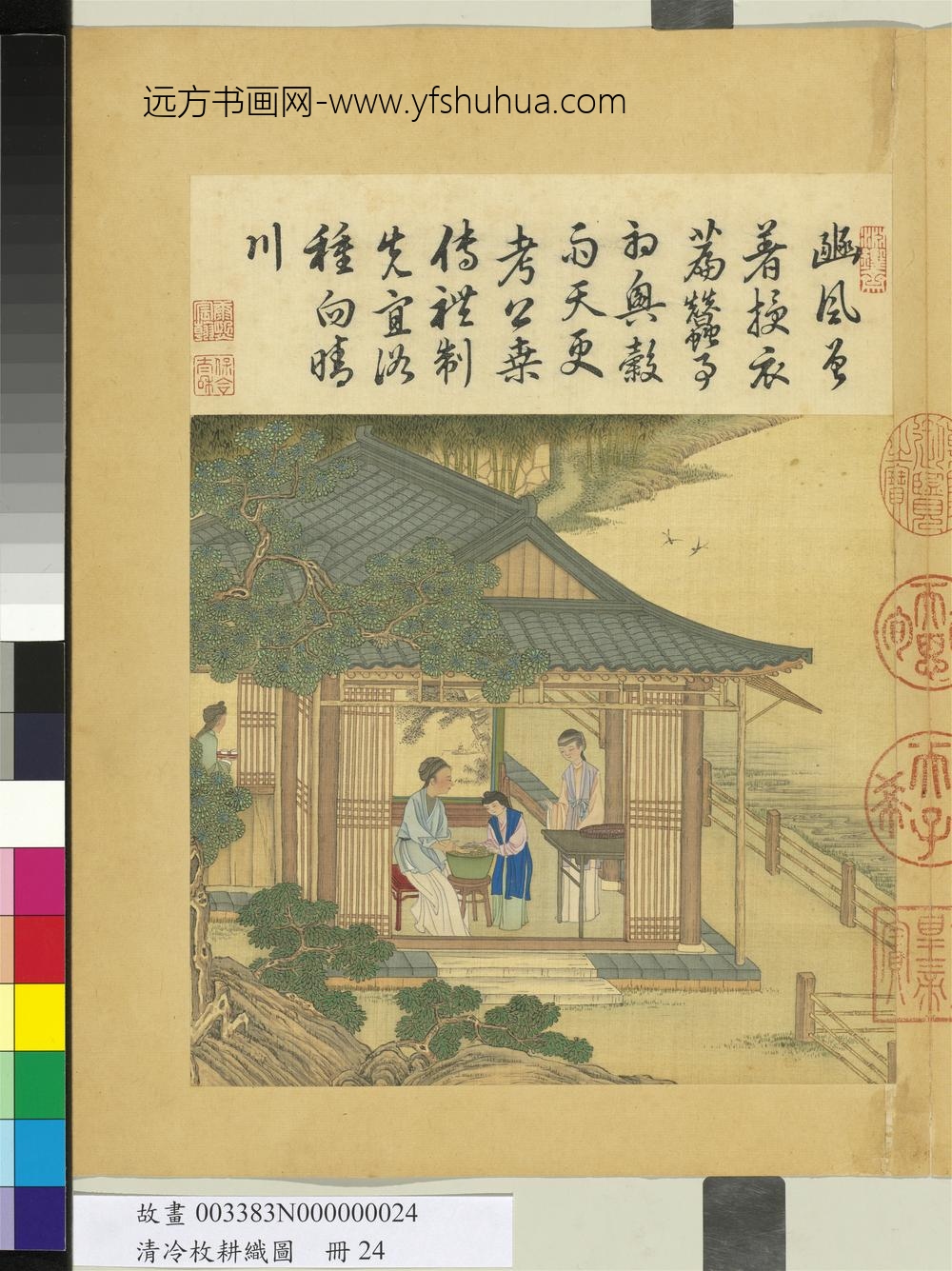
耕织图册_浴蚕
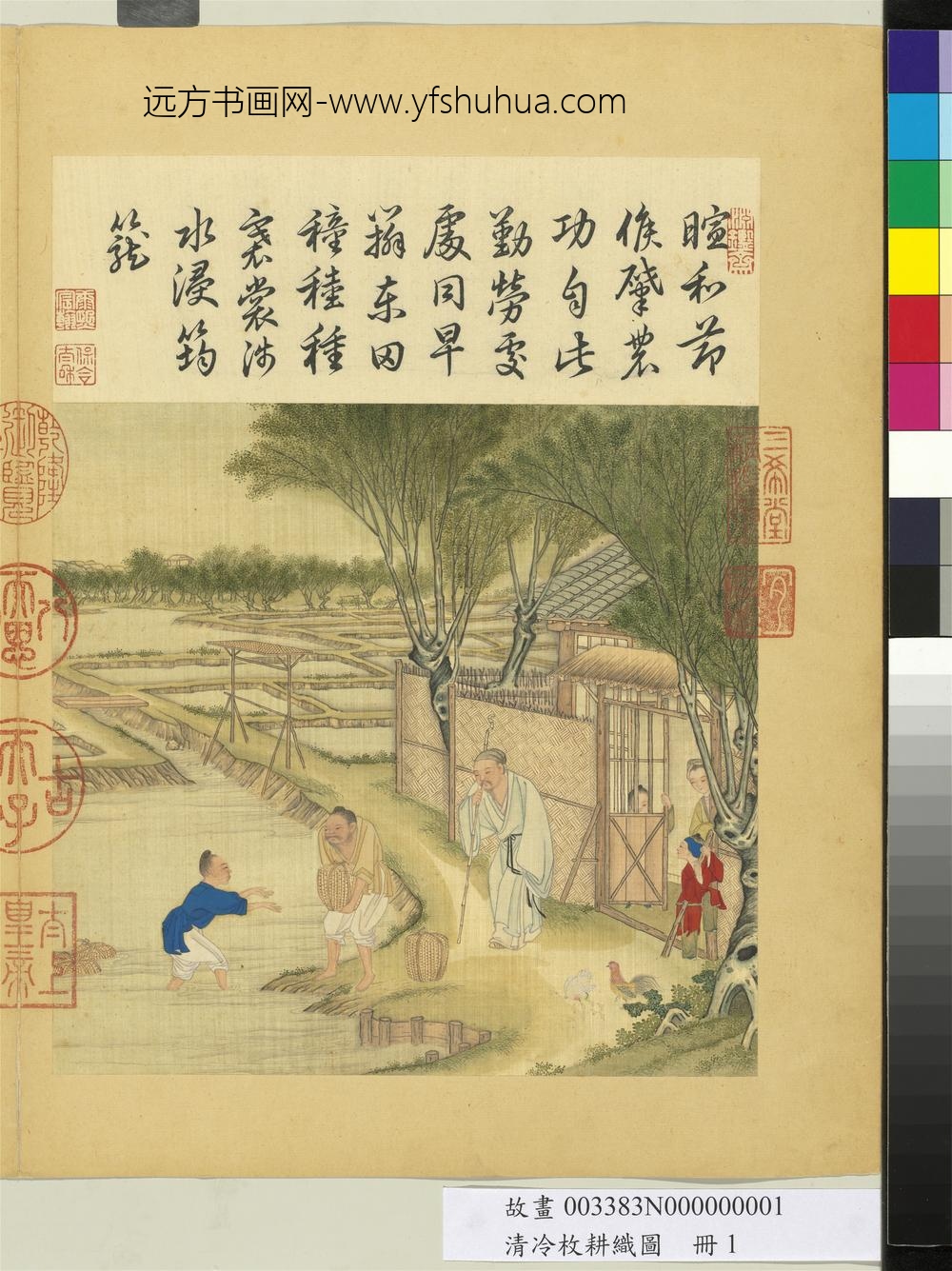
耕织图册_浸种
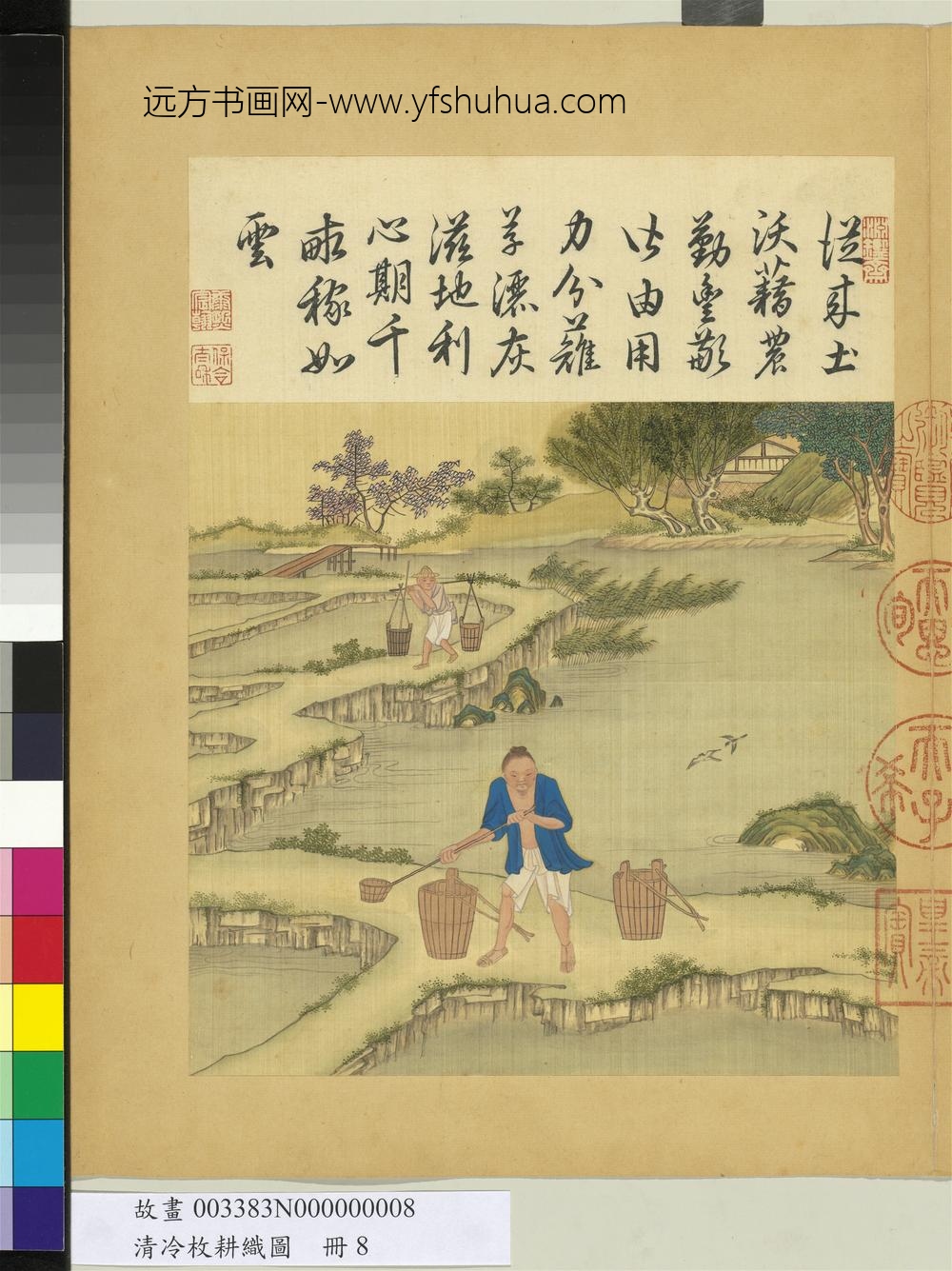
耕织图册_游荫
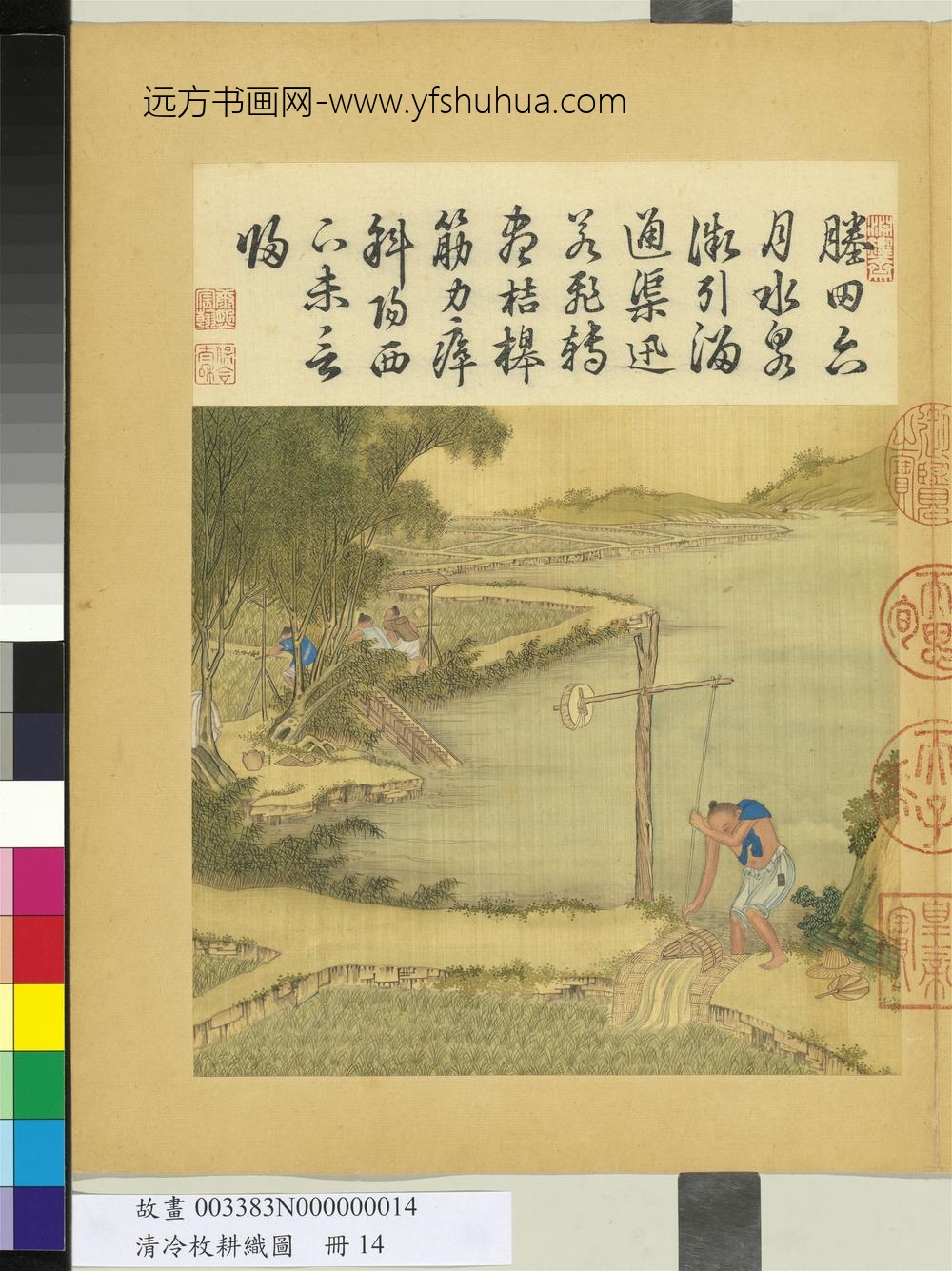
耕织图册_灌激
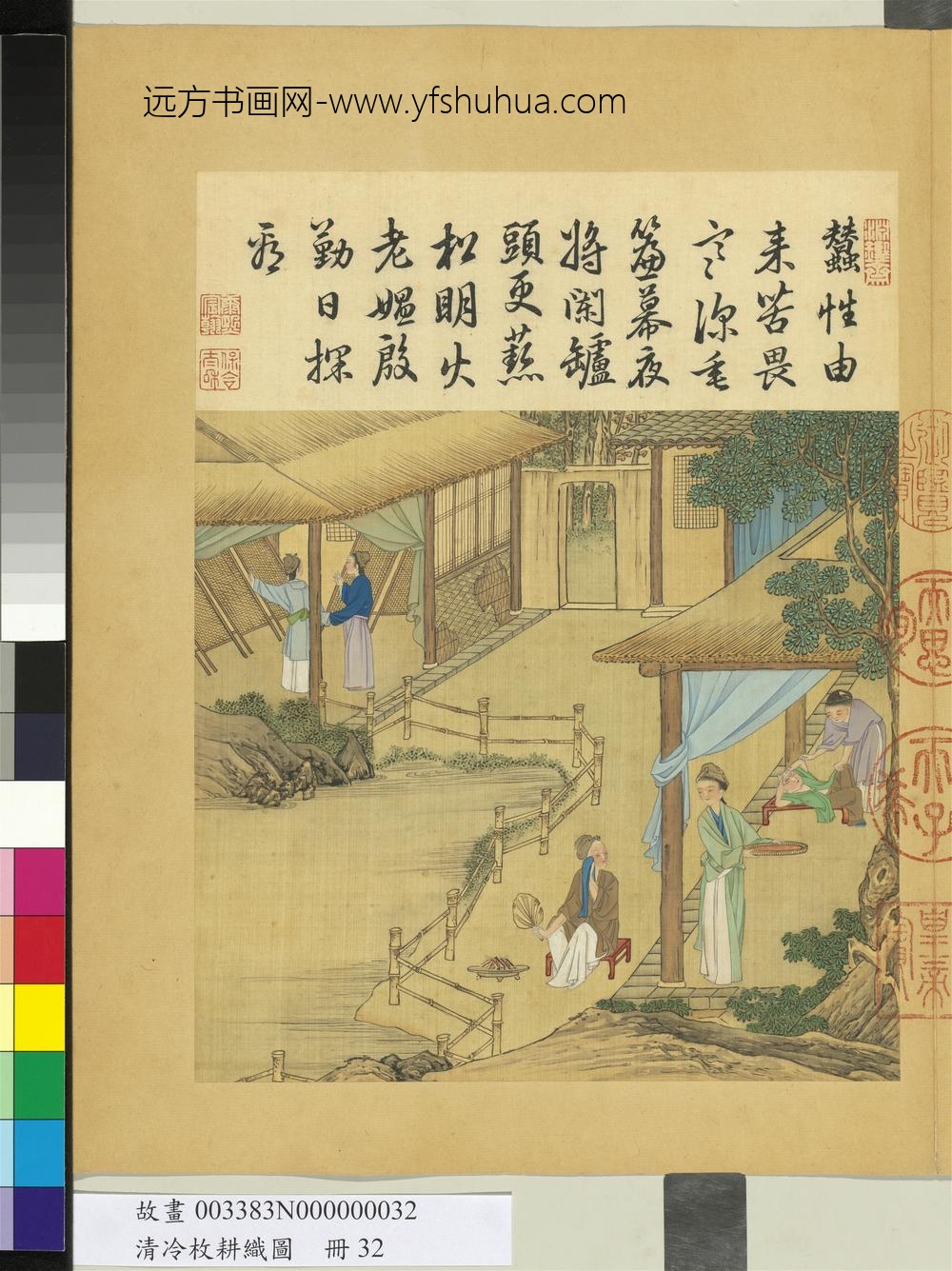
耕织图册_炙箔
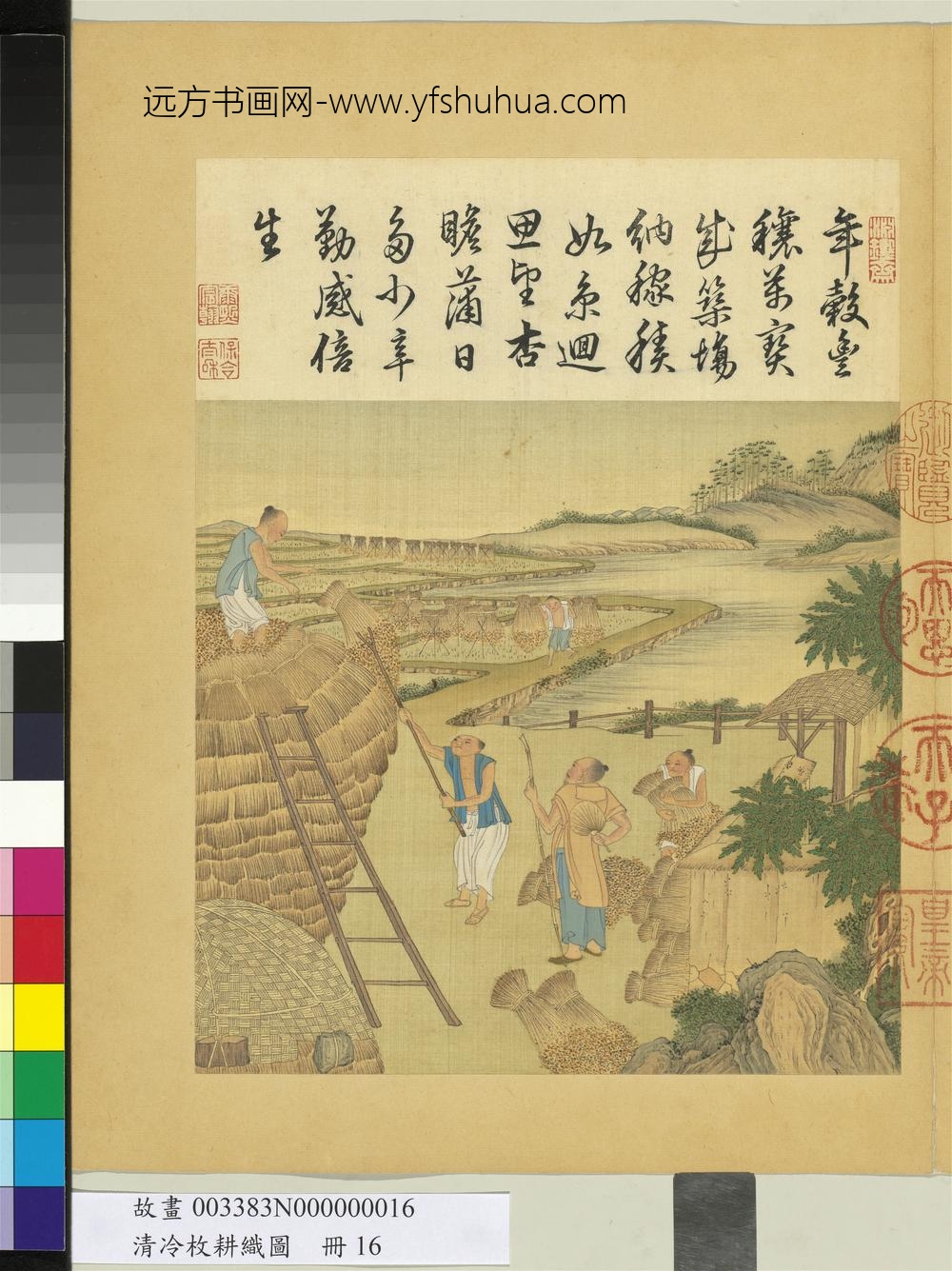
耕织图册_登场
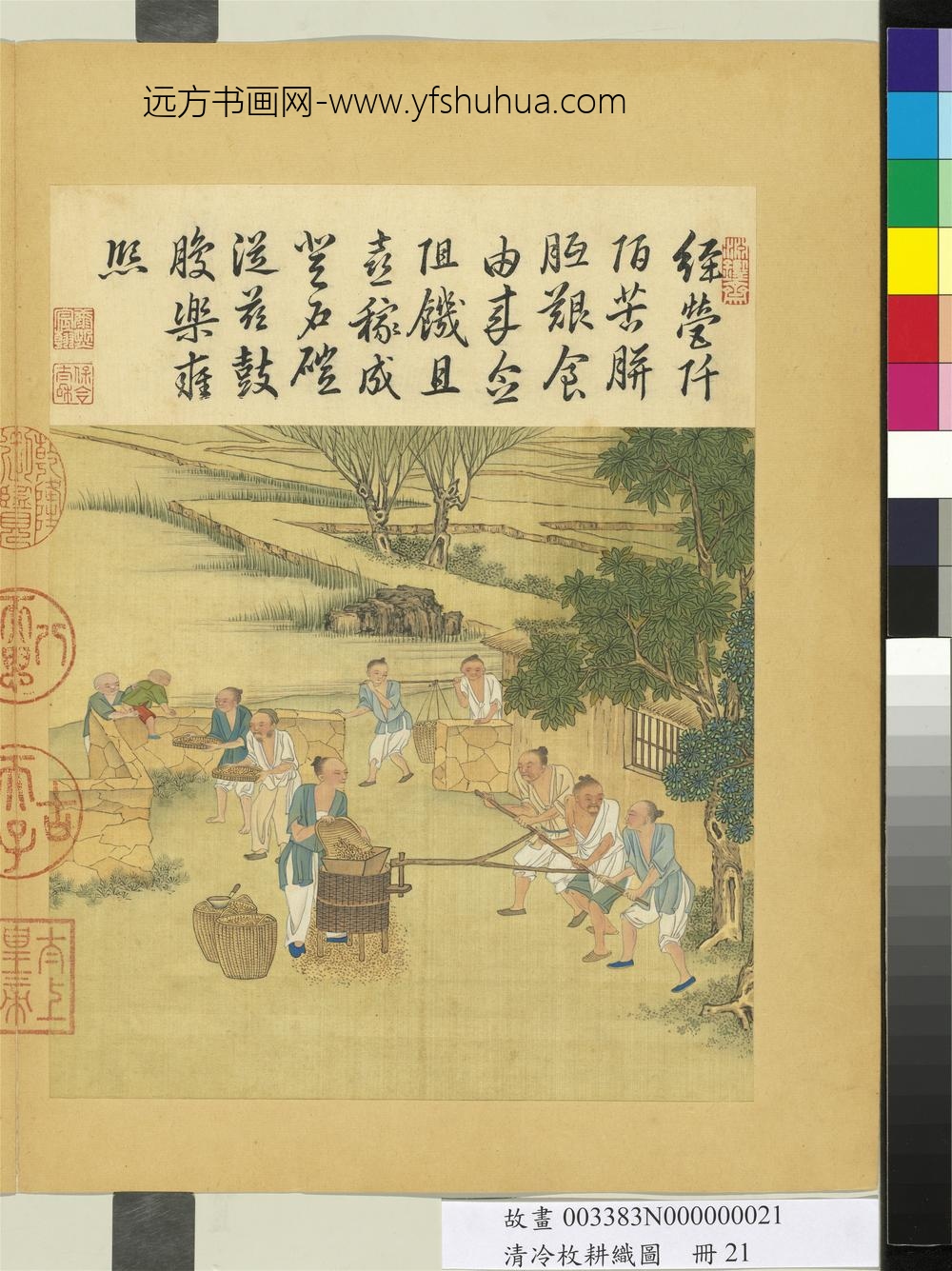
耕织图册_砻
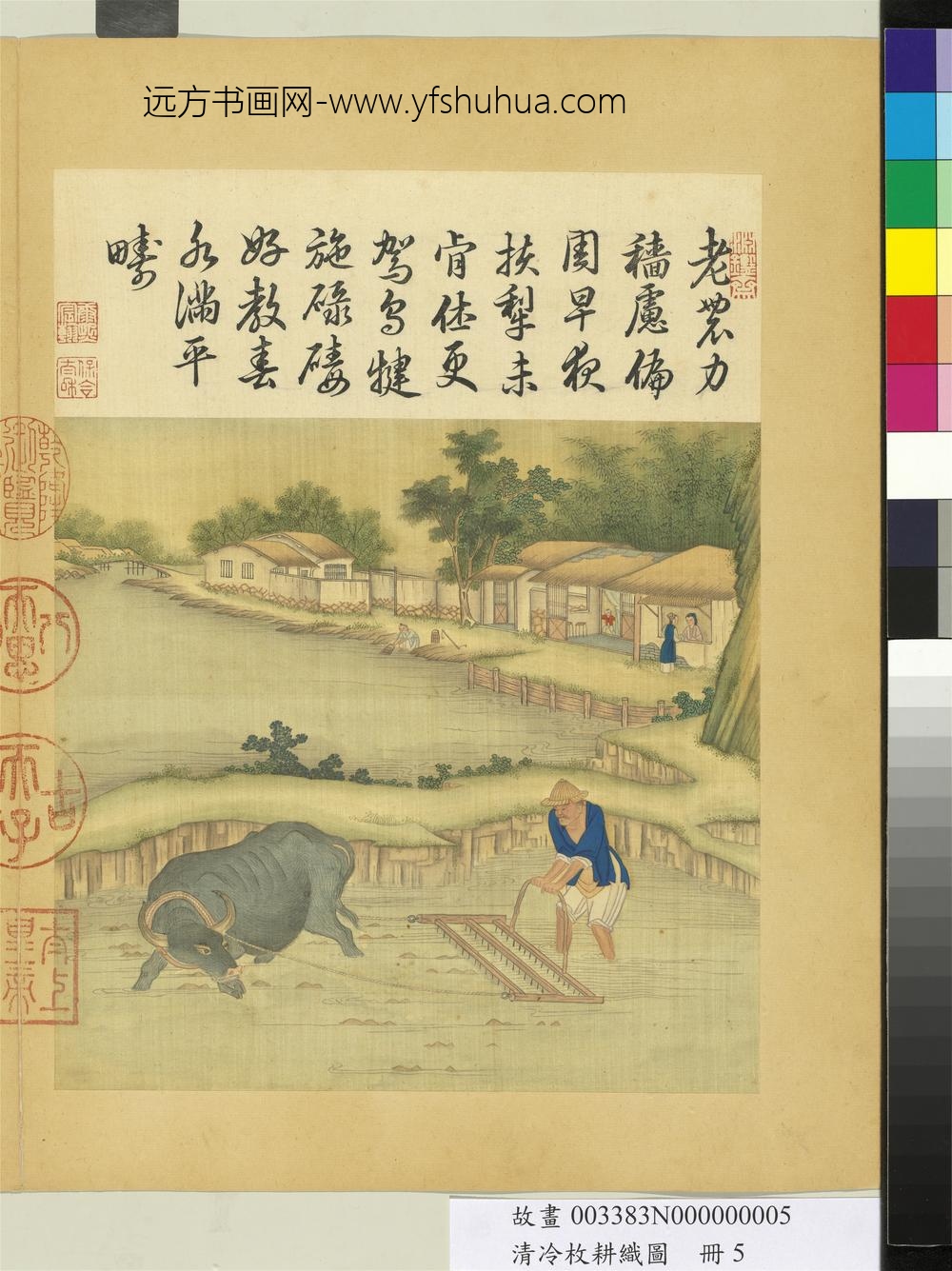
耕织图册_碌碡
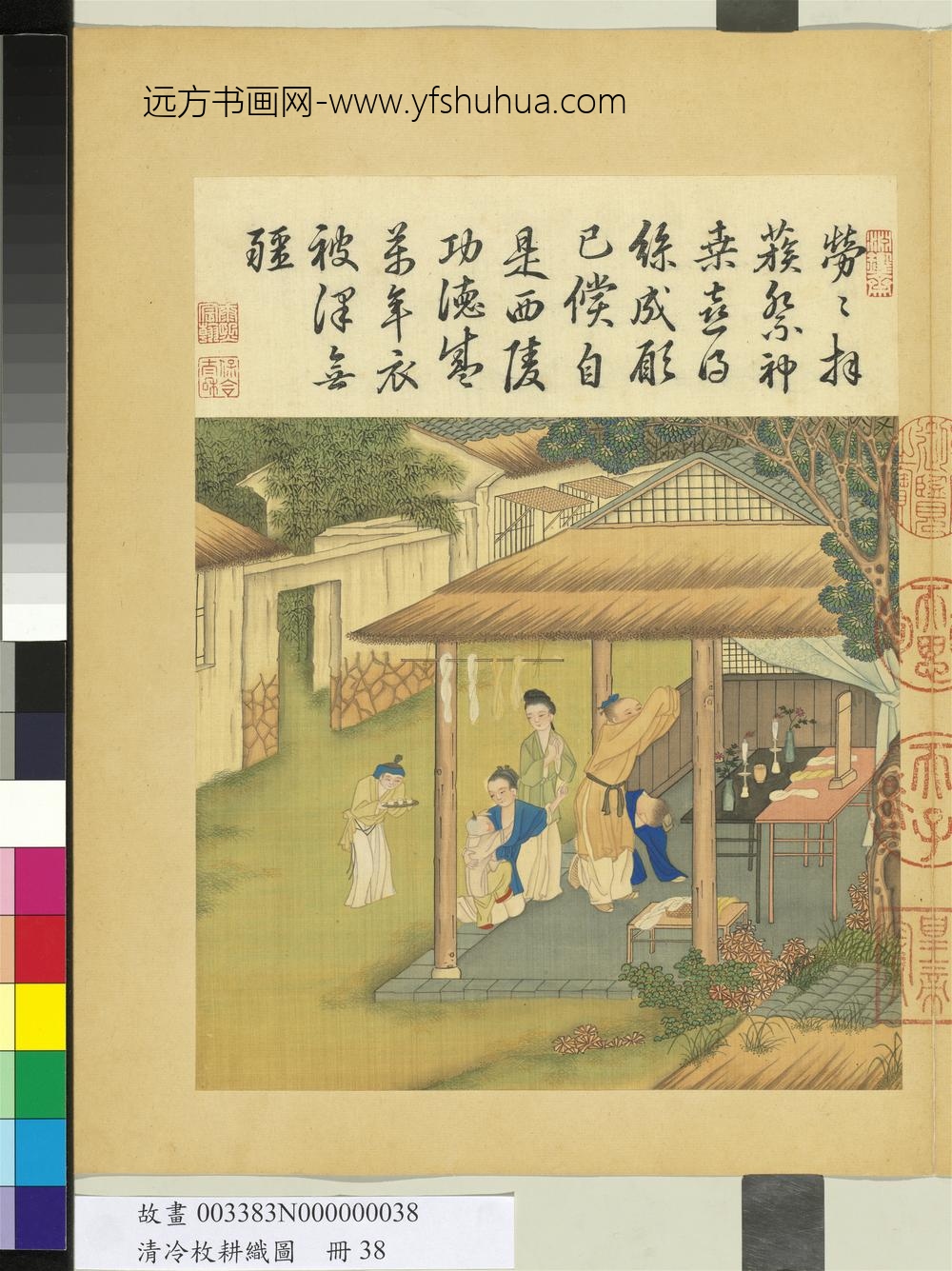
耕织图册_祀谢
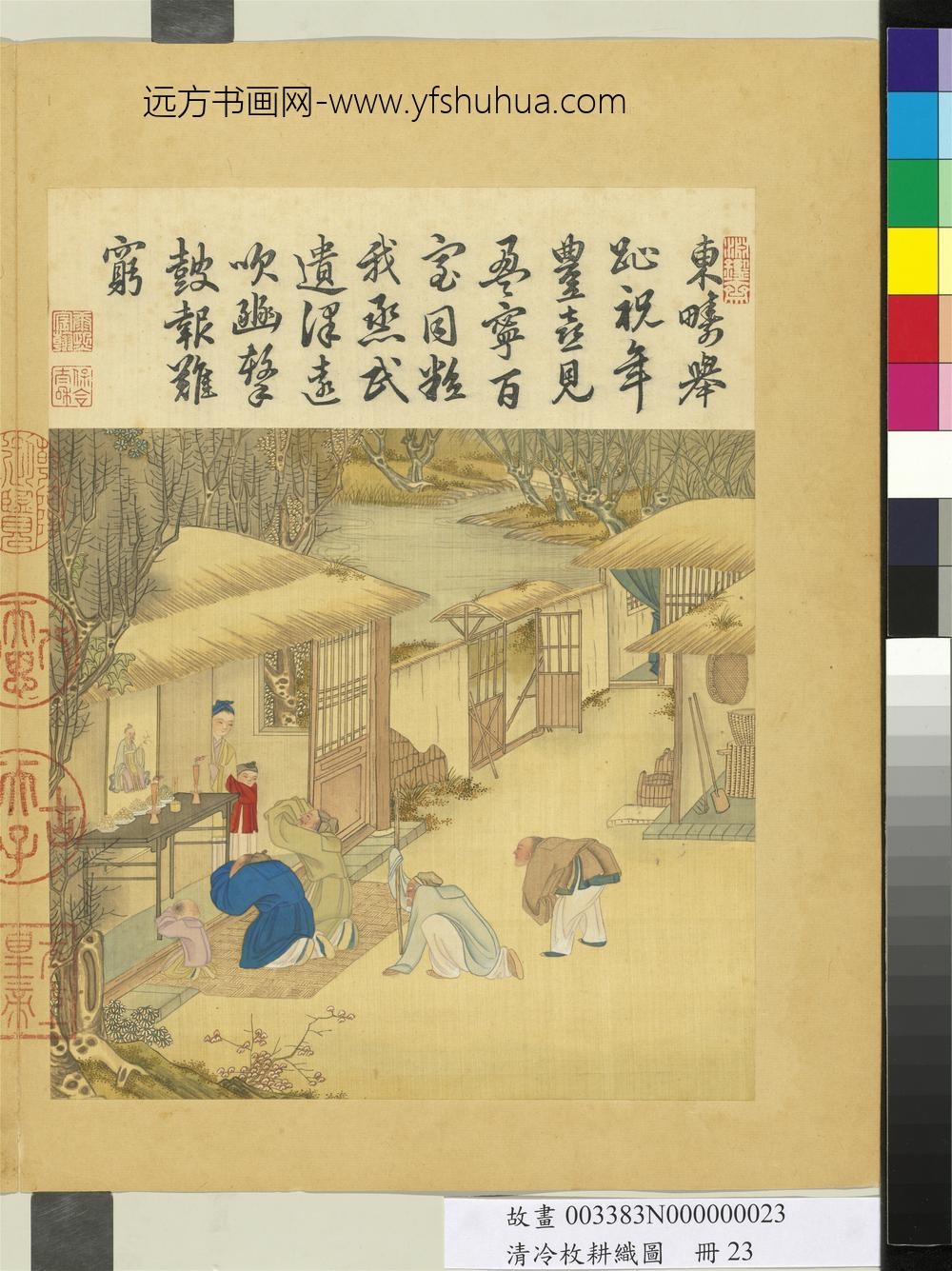
耕织图册_祭神
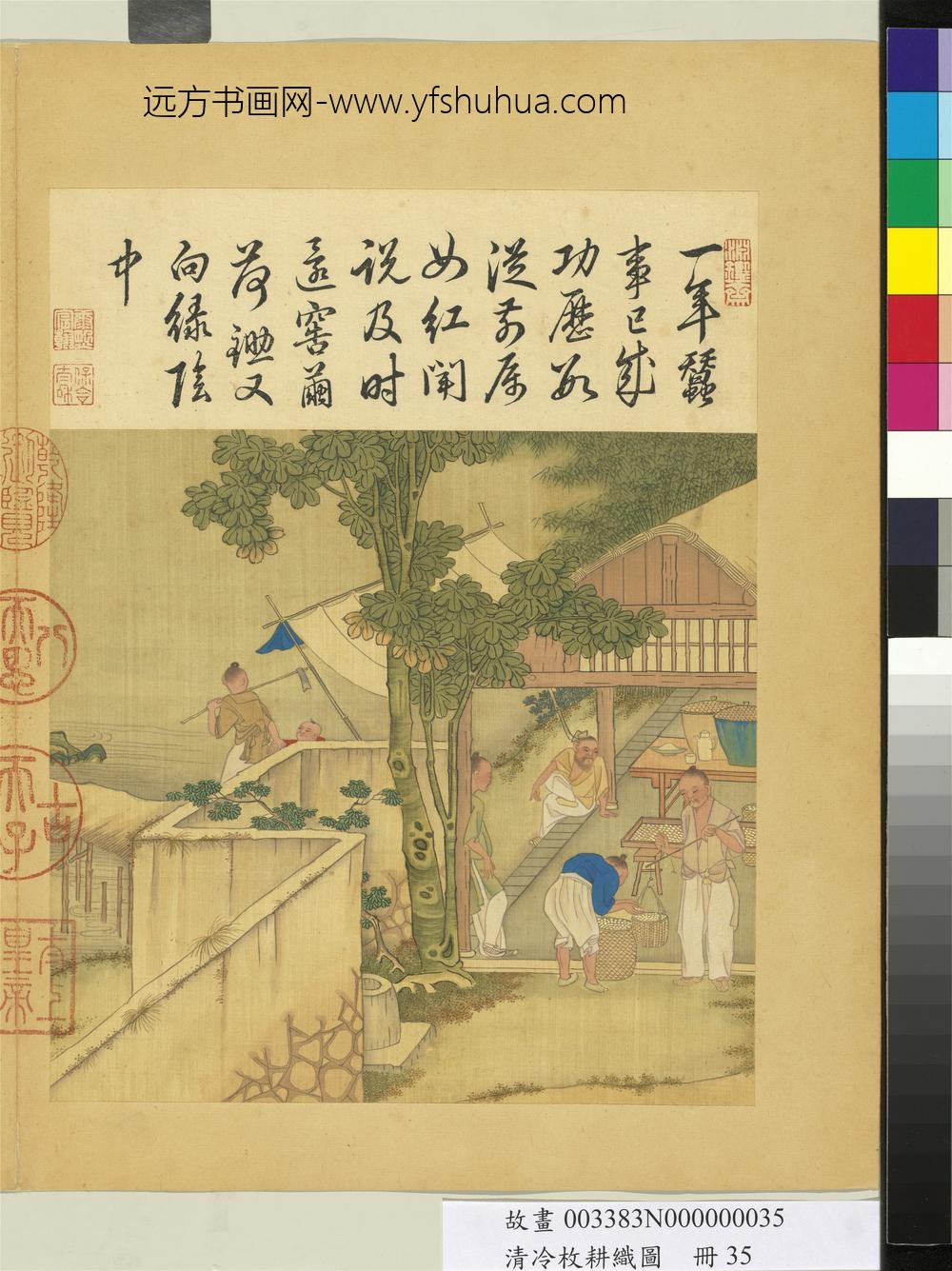
耕织图册_窖茧
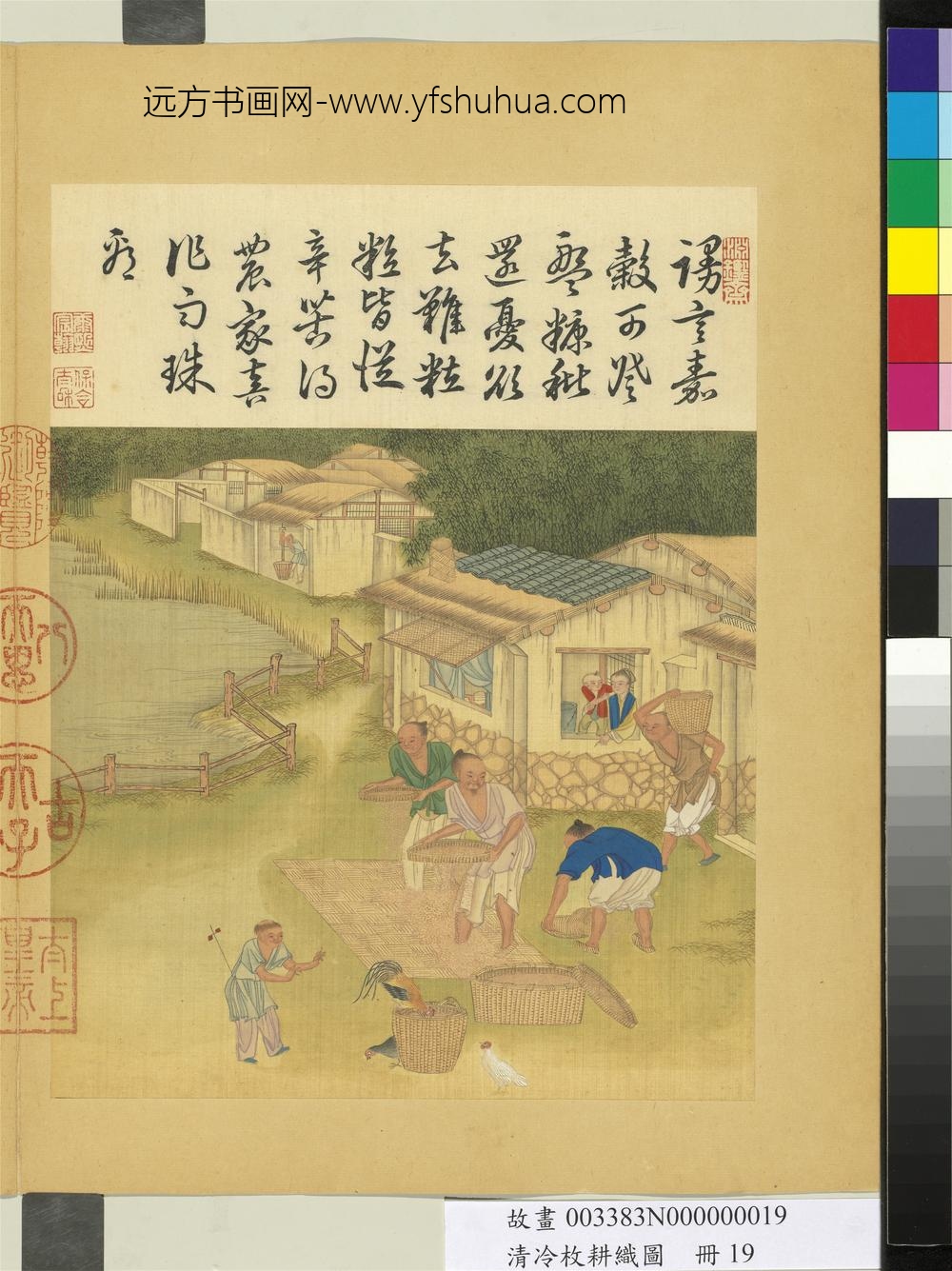
耕织图册_簏
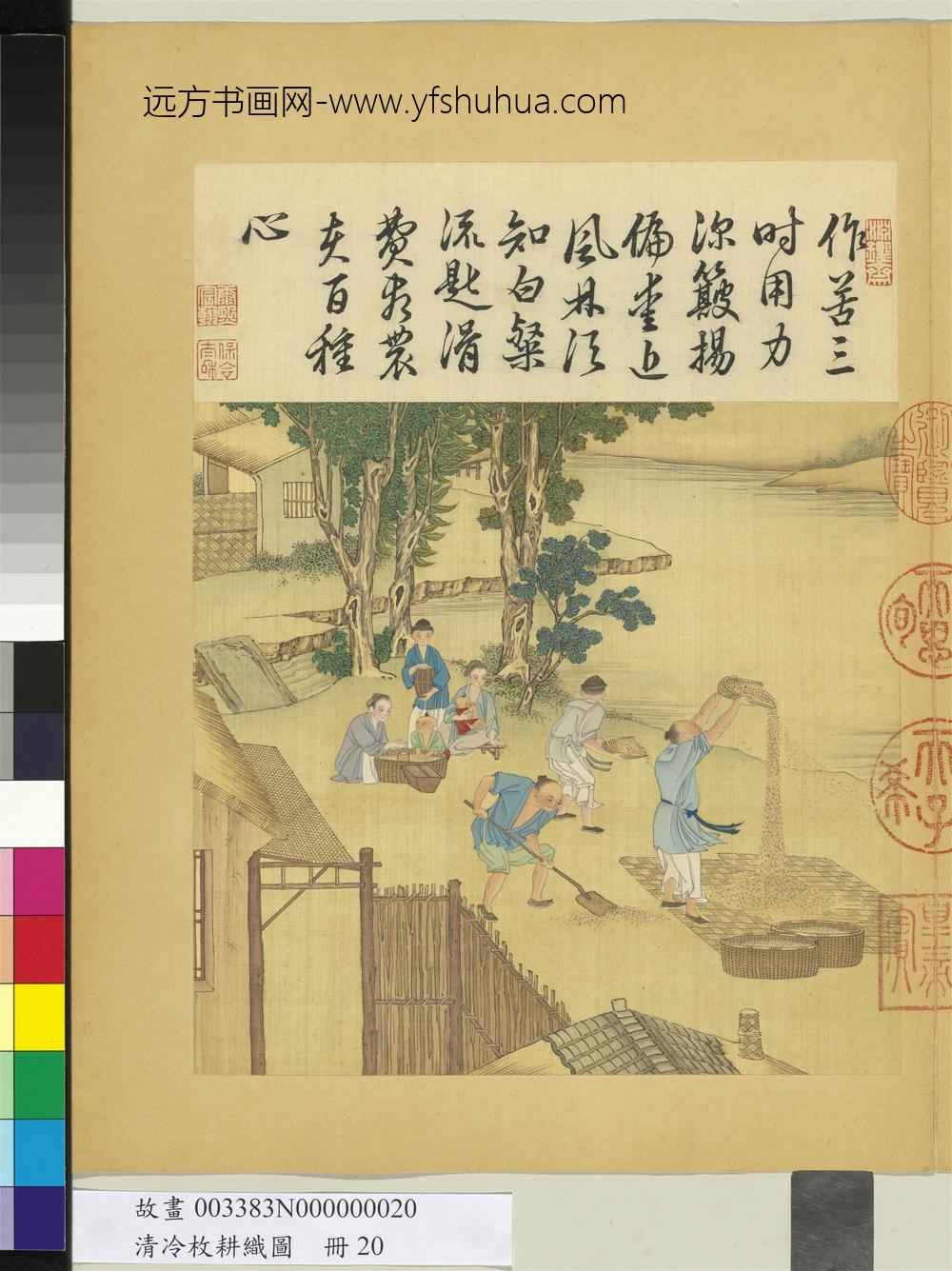
耕织图册_簸扬
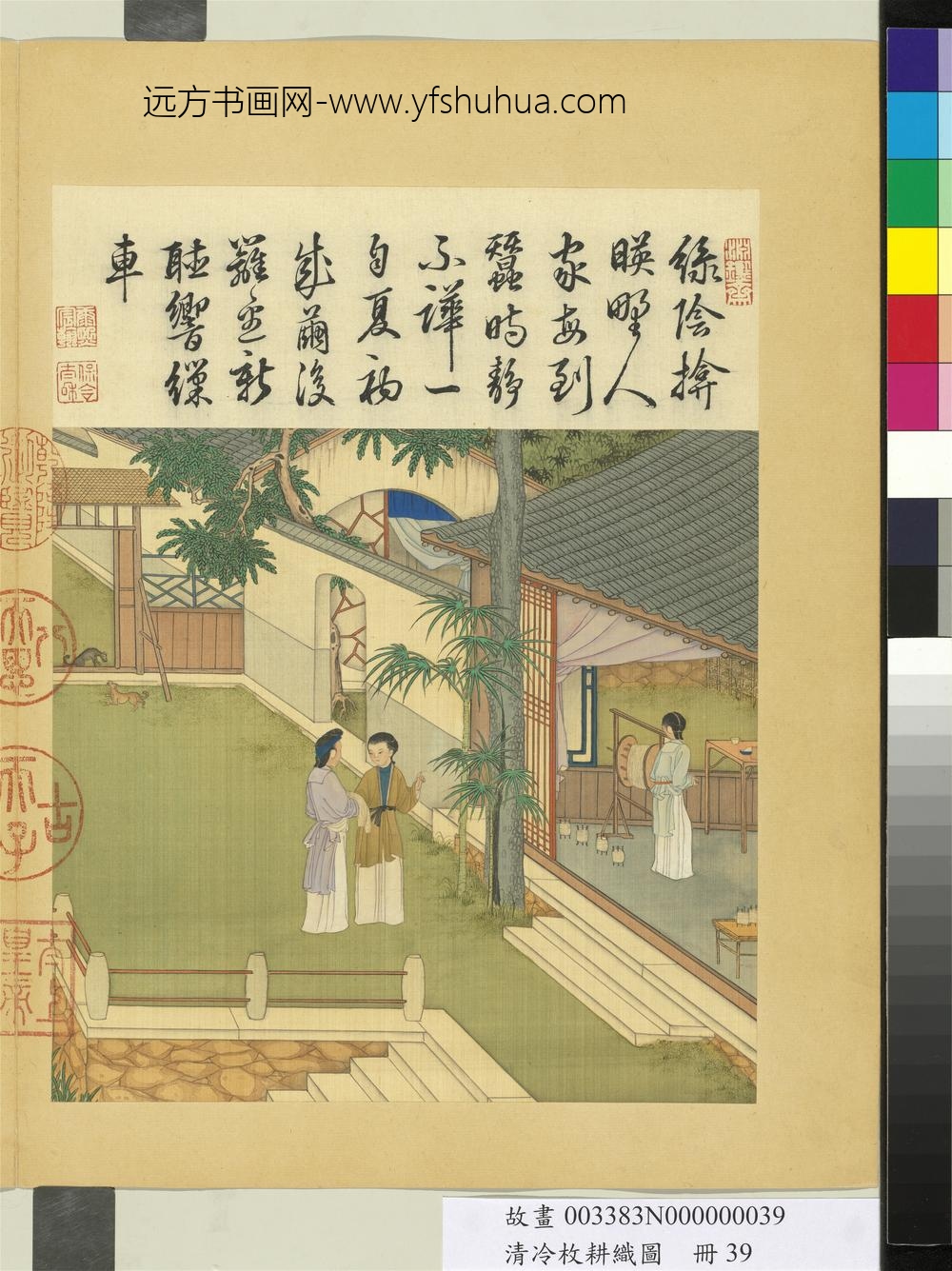
耕织图册_纬
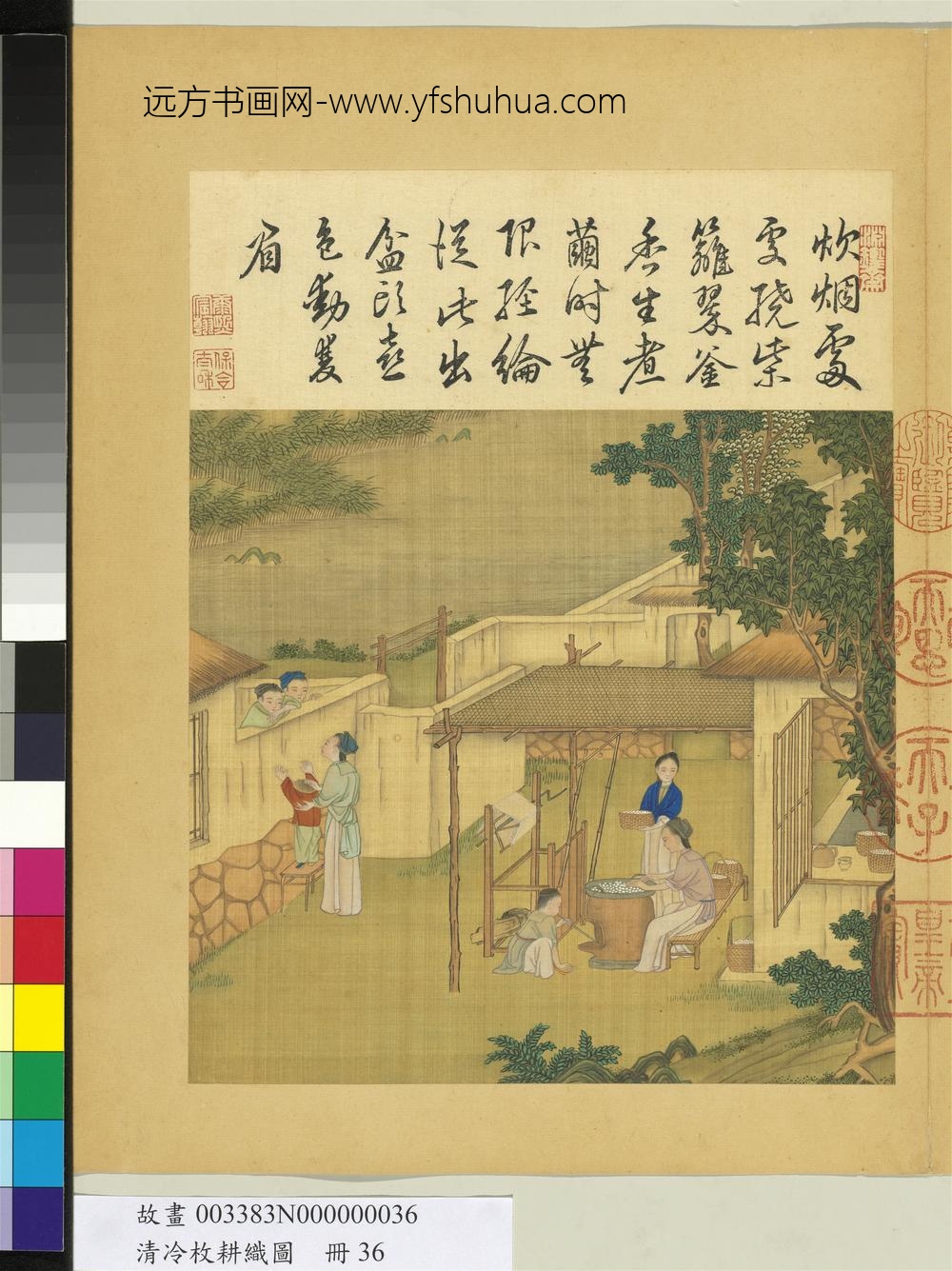
耕织图册_练丝
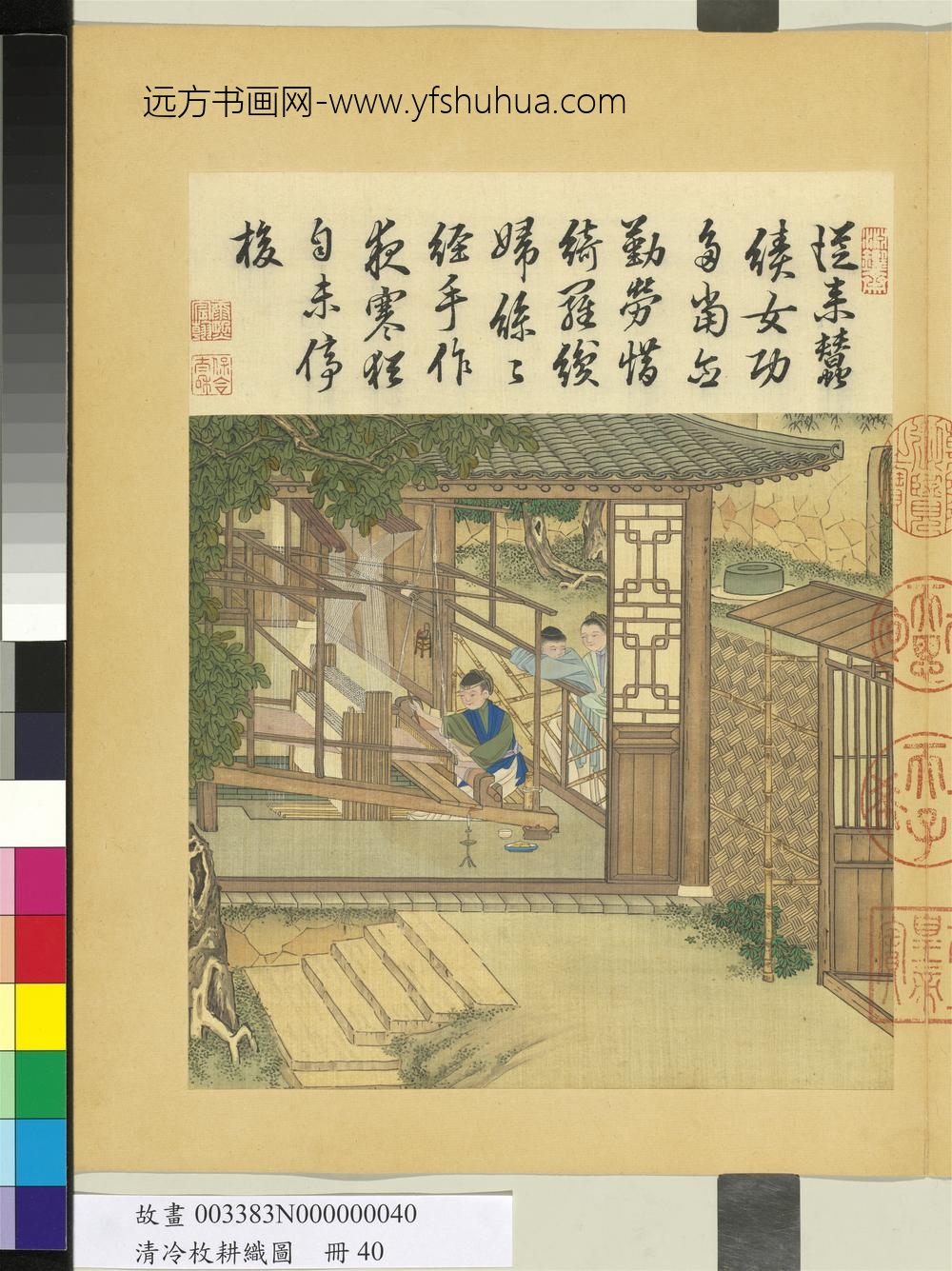
耕织图册_织
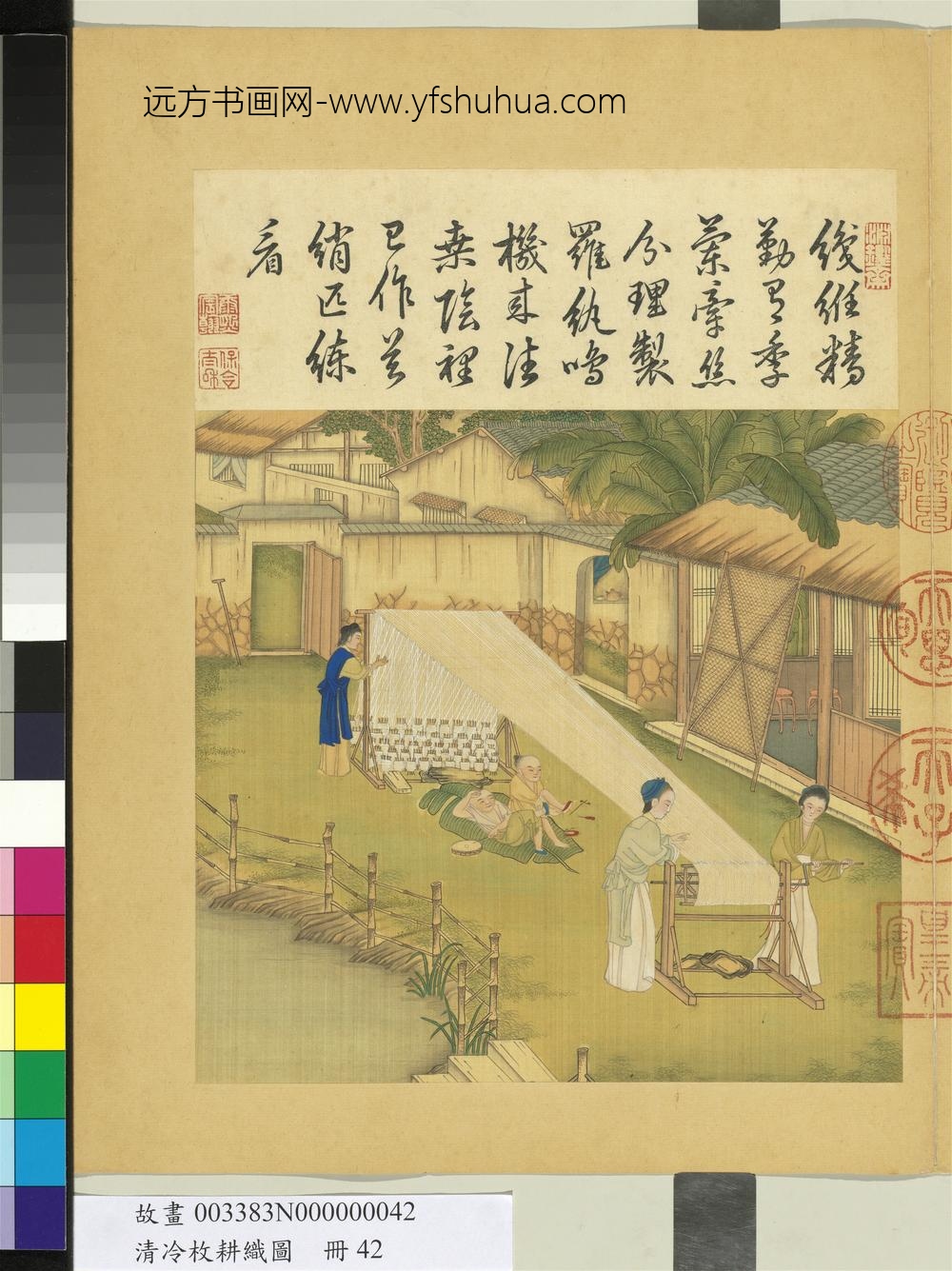
耕织图册_经
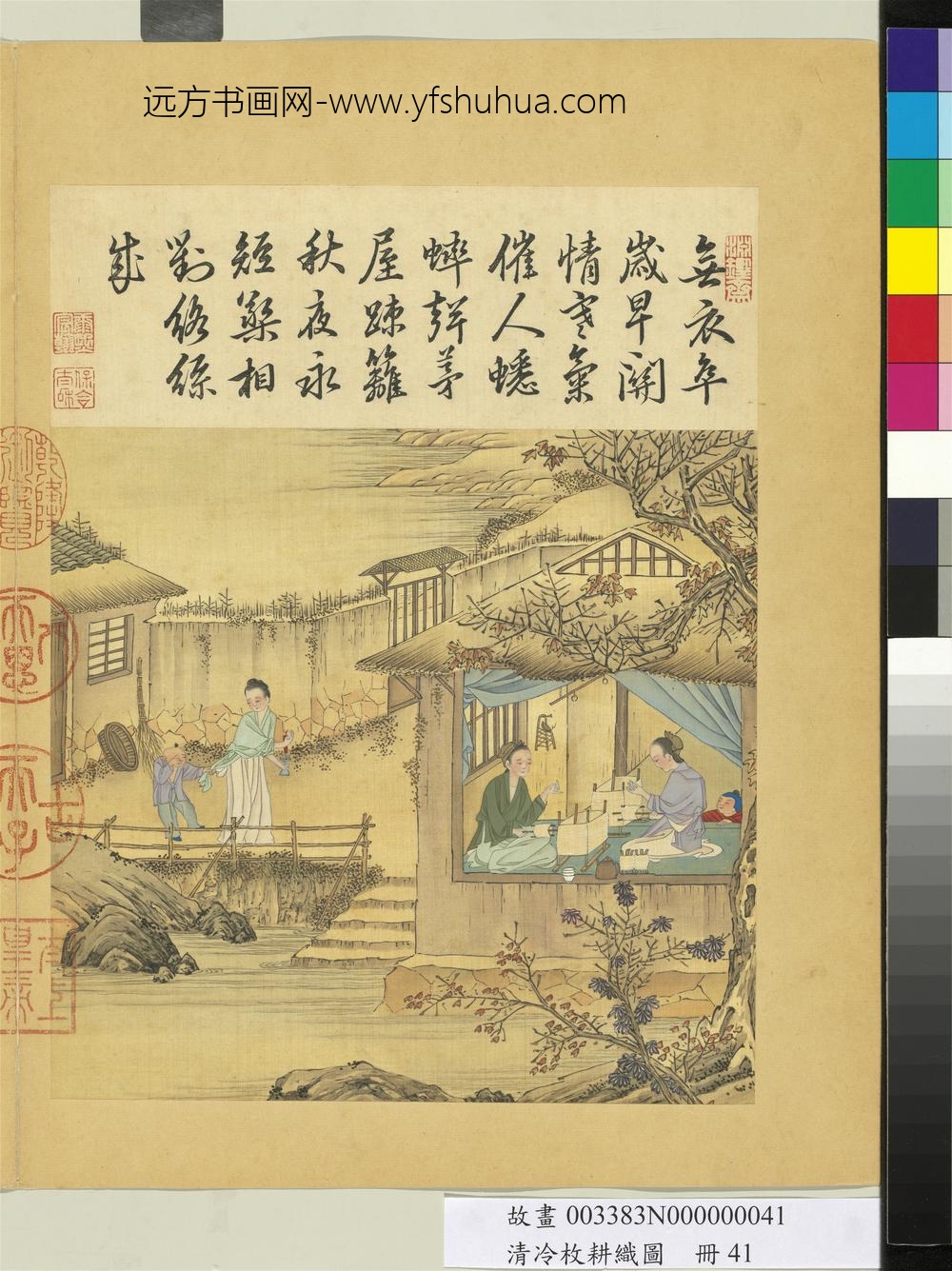
耕织图册_络丝
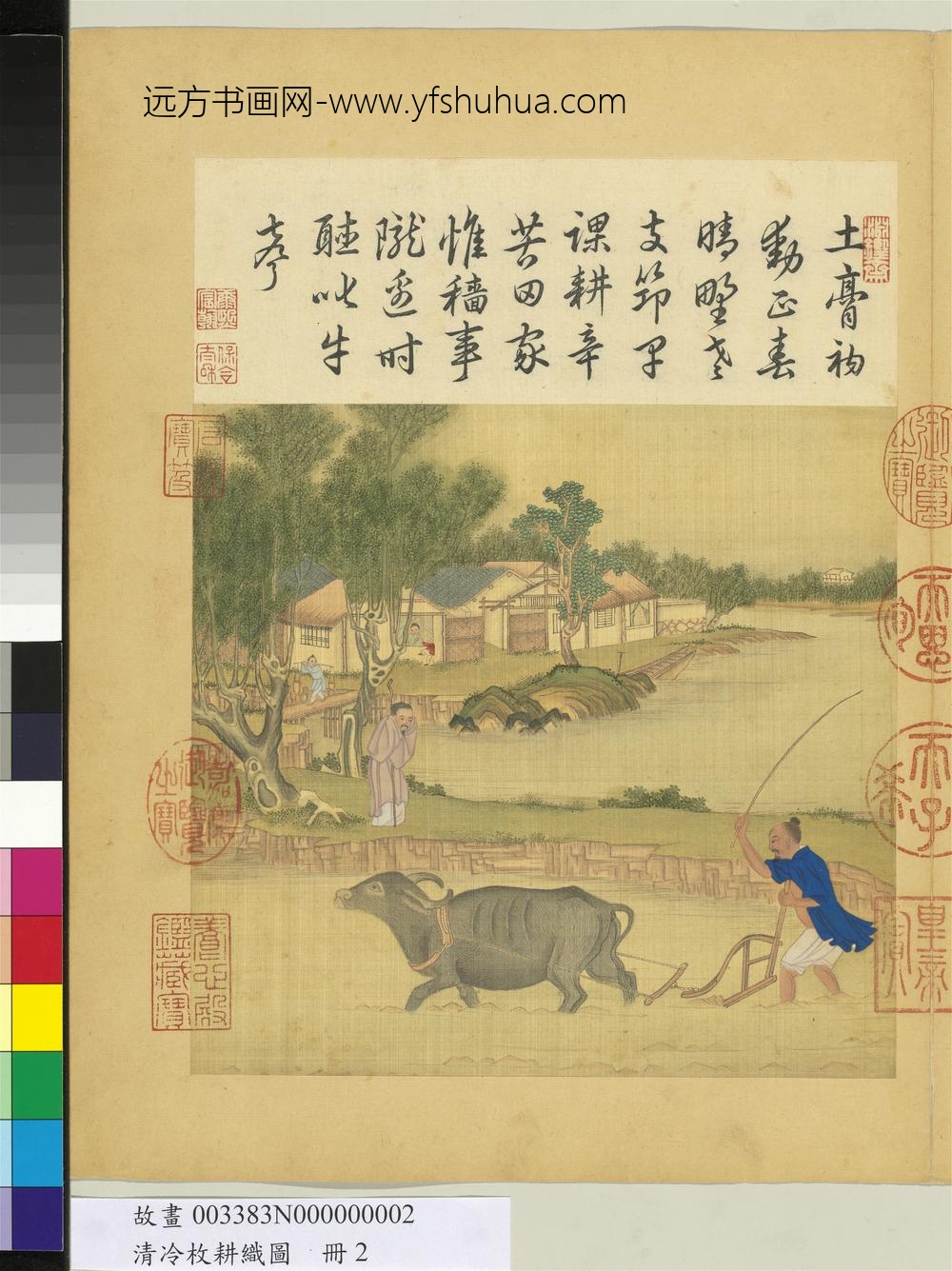
耕织图册_耕
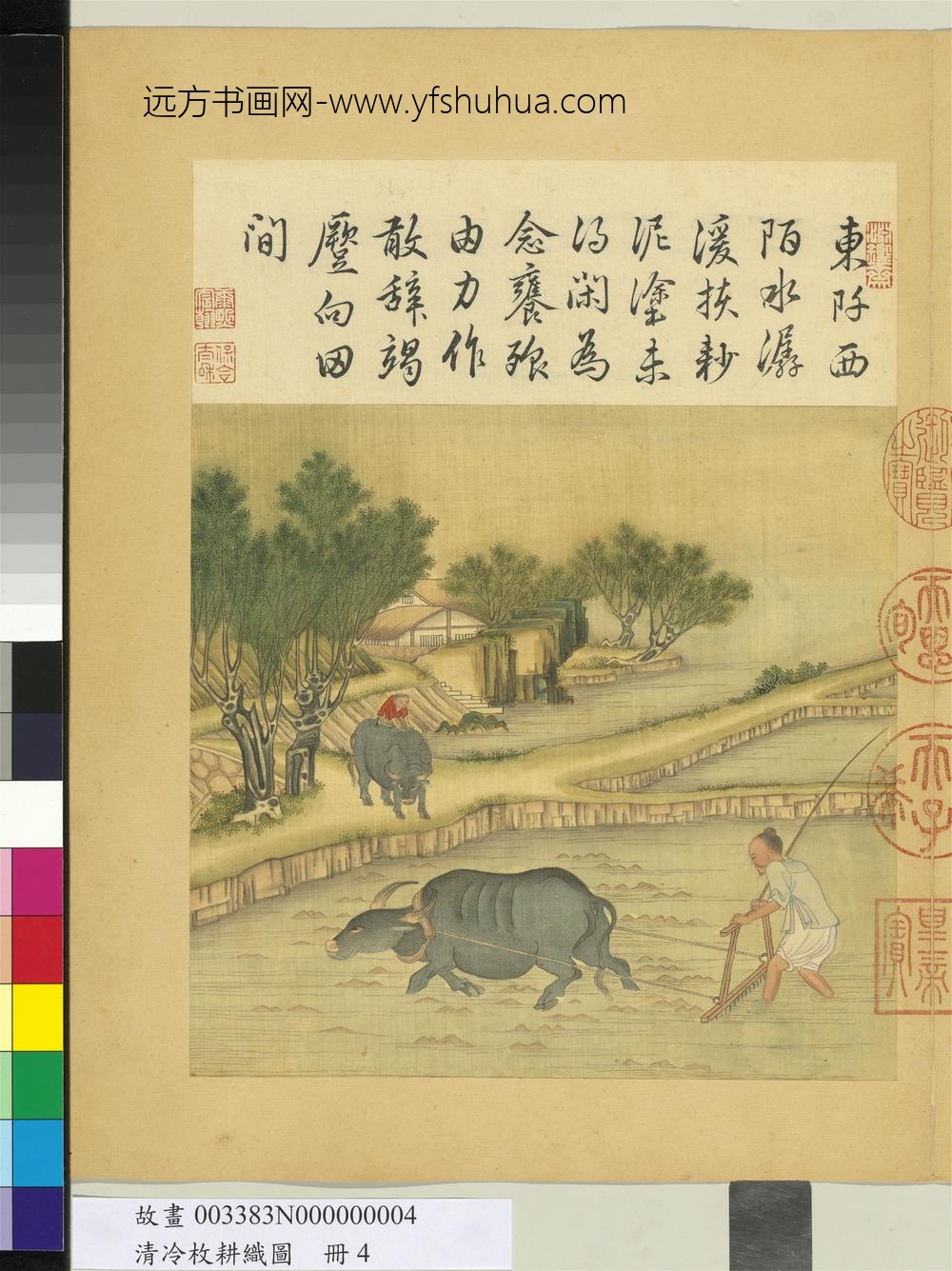
耕织图册_耖
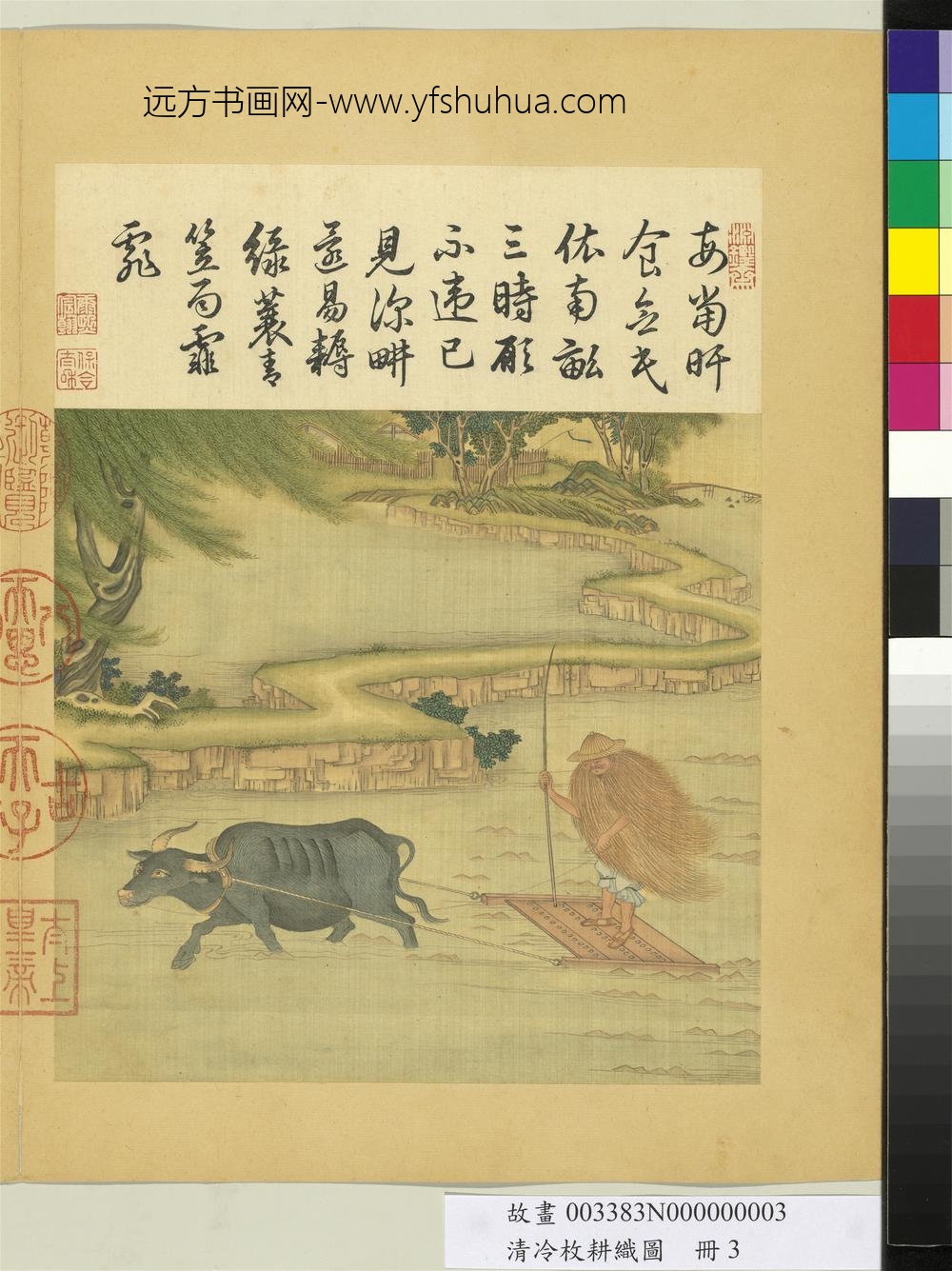
耕织图册_耙耨
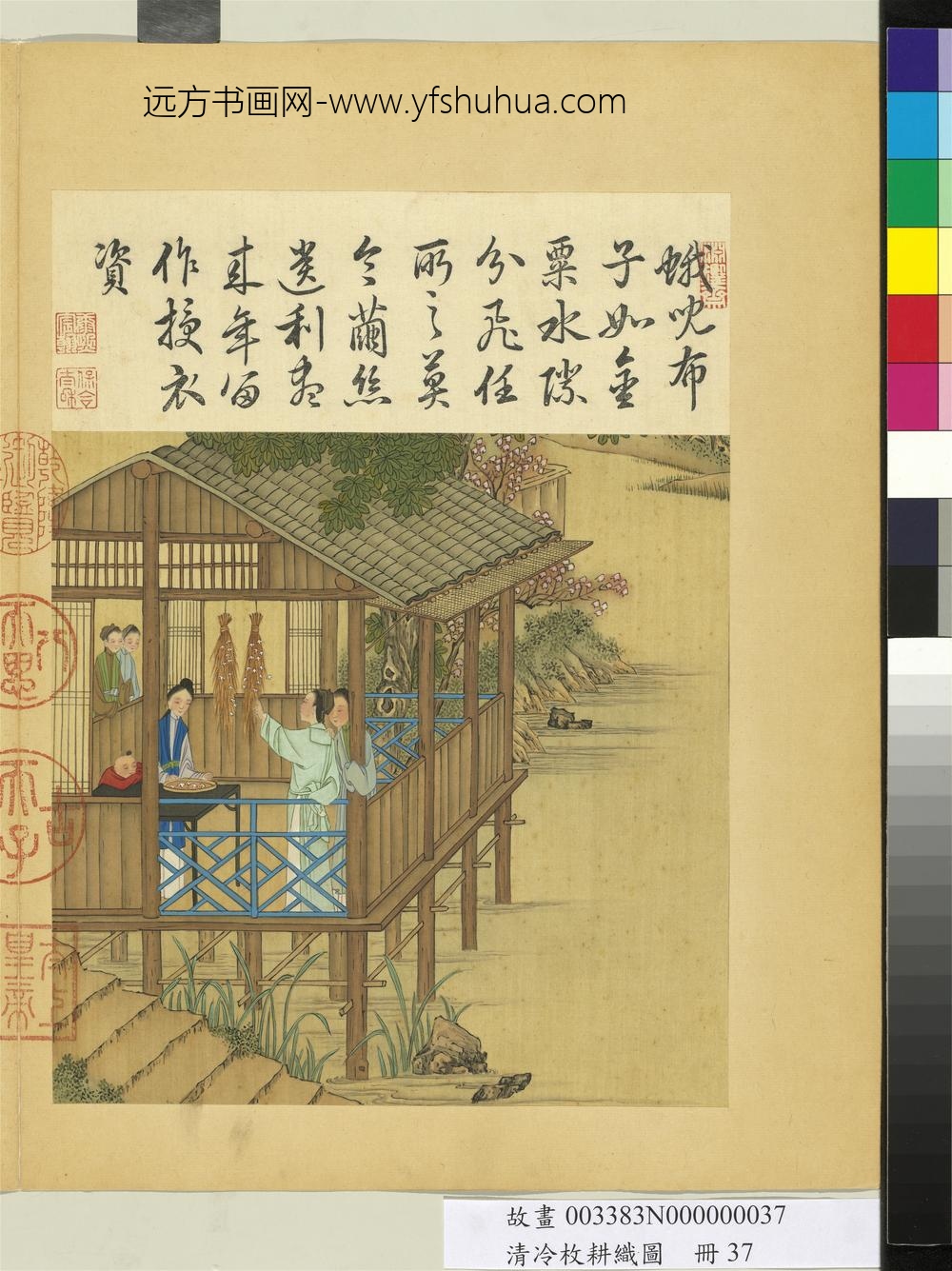
耕织图册_蚕蛾
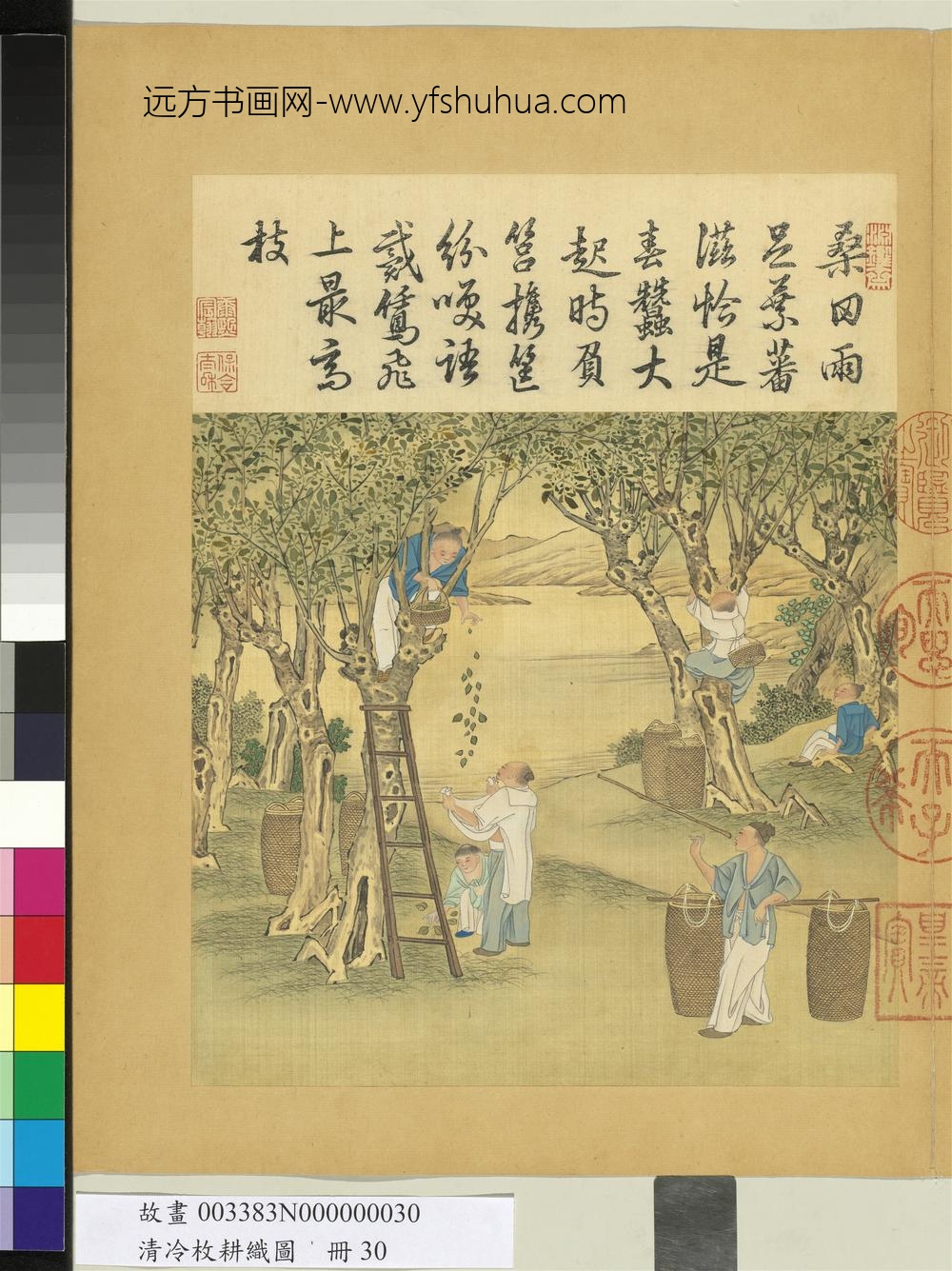
耕织图册_采桑
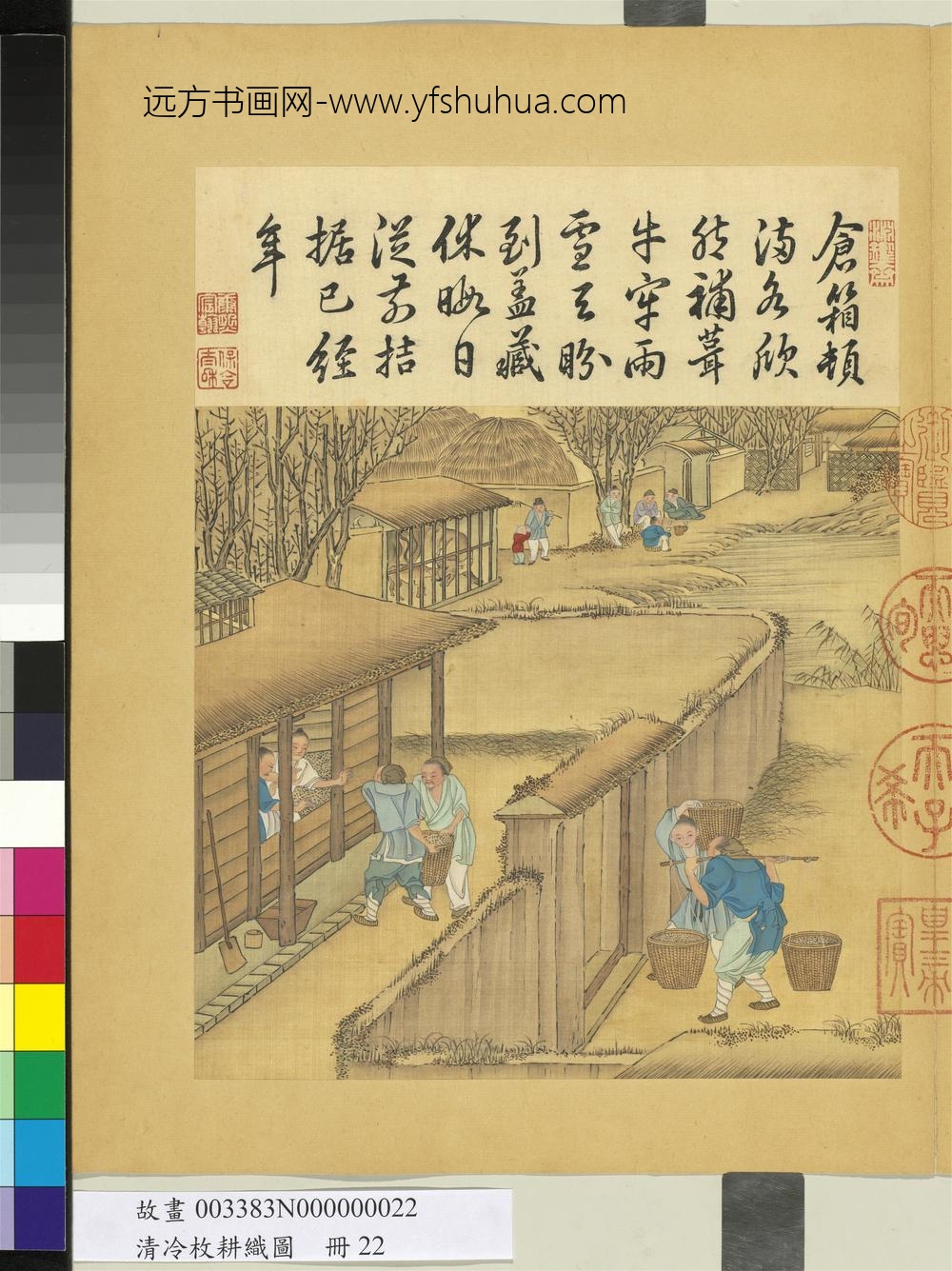
耕织图册_霜降

